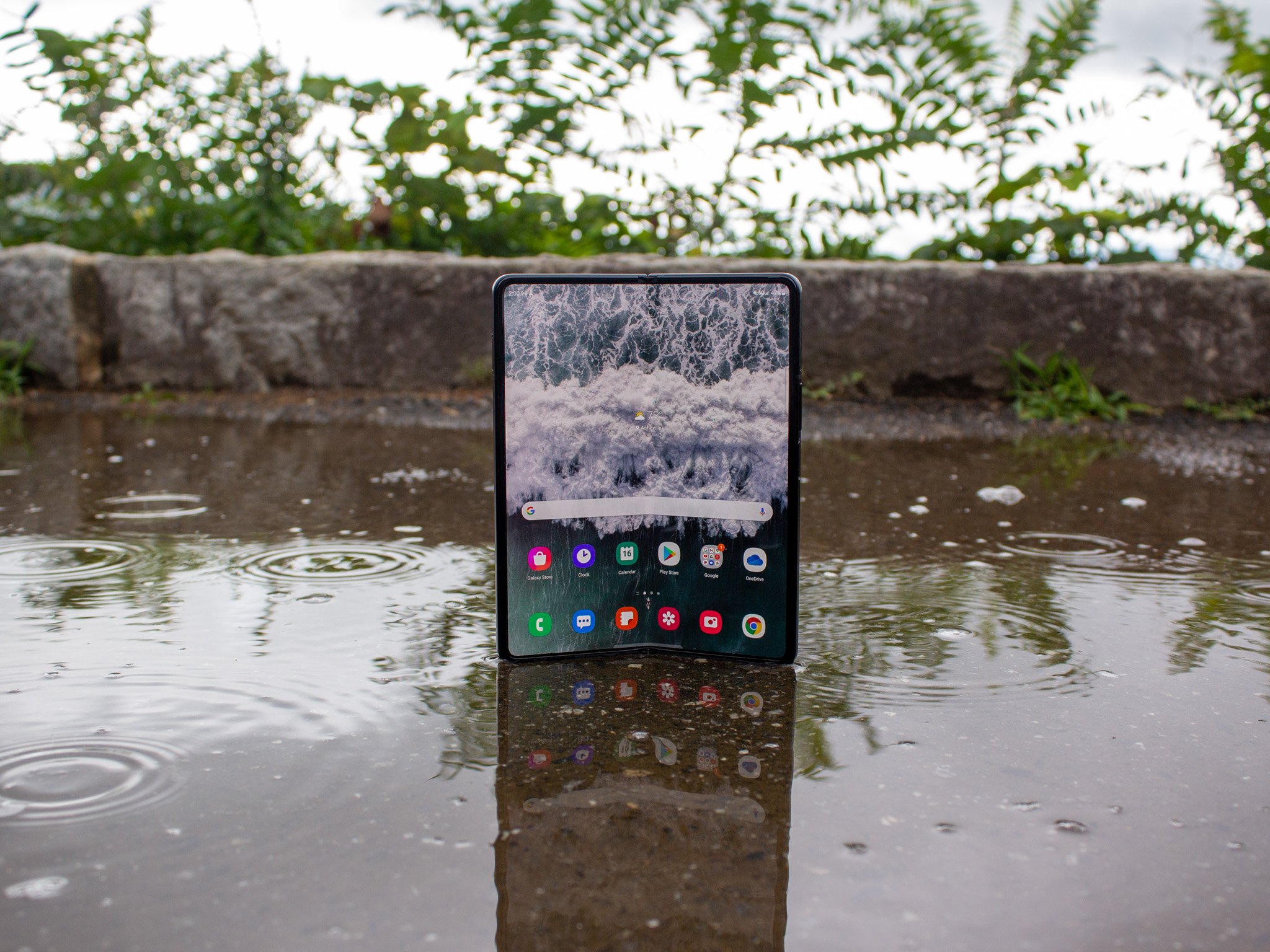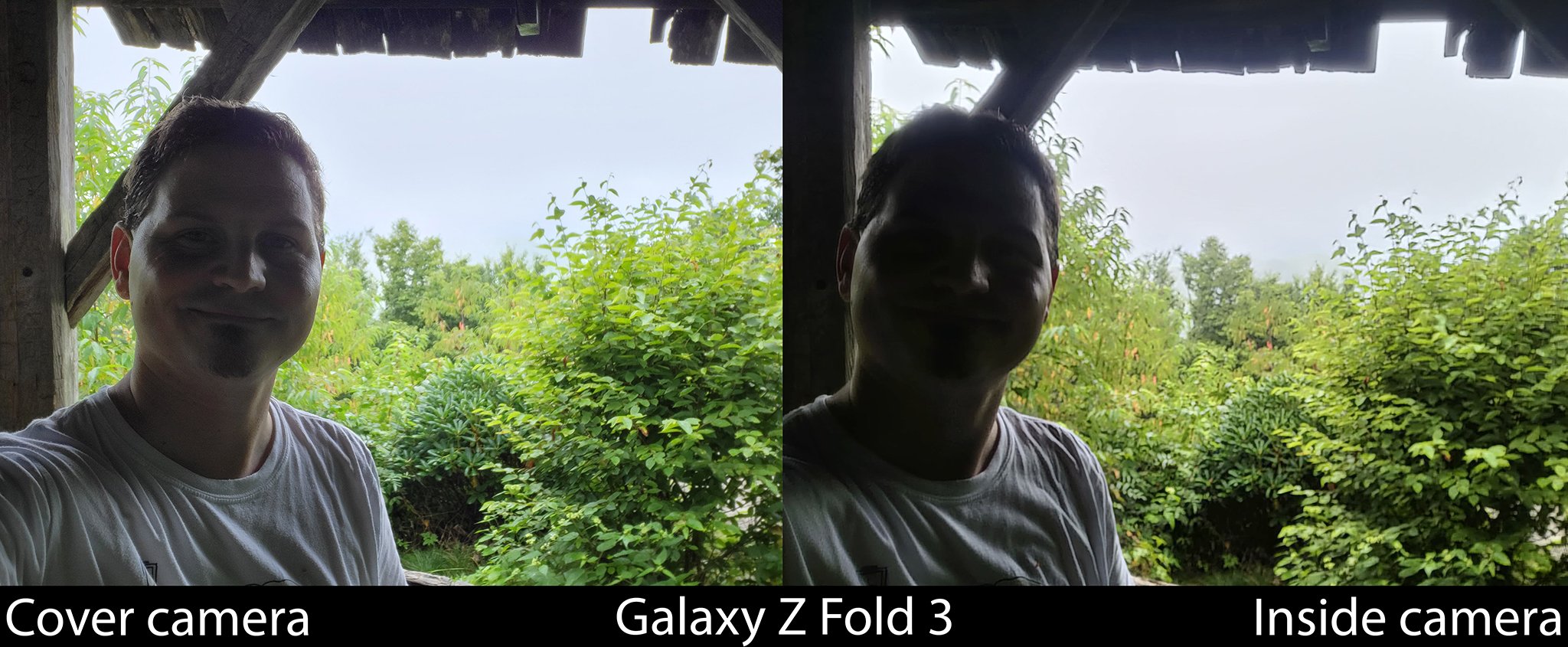Android Central Verdict
Samsung made all the right changes with the Z Fold 3, finally giving people a good reason to consider a foldable phone without making serious concessions. S Pen support and new multitasking features will make Note users jump for joy, and nicer screen protectors and water resistance mean you can confidently use this phone in any situation.
Pros
- +
Blazing performance
- +
Reliably good cameras
- +
Feels like a digital notebook with the S Pen
- +
The best multitasking
- +
More refined software than last year
- +
A uniquely amazing experience
Cons
- -
No storage for the S Pen
- -
Cameras aren't up to par with the Galaxy S21 Ultra
- -
Foldable crease is still noticeable
- -
Eye-watering price
Why you can trust Android Central
For its third generation of foldables, Samsung seemingly didn't hold anything back. The Galaxy Z Fold 3 is Samsung's top-tier foldable phone, featuring more RAM, more storage, an upgraded outer screen, bigger (and more) screens, better cameras, new screen protectors, and support for the fabled S Pen. It may still have the same physical camera hardware as last year's Galaxy Z Fold 2, but software improvements make it a much better camera than the specs suggest.
Despite the importance placed on quality-of-life features like the addition of water resistance — something consumers have come to take for granted in the best Android phones — the real revolutionary feature lies in the Z Fold 3's compatibility with the S Pen. As the unofficial replacement for the Galaxy Note series in 2021, the Galaxy Z Fold 3 form factor achieves a goal no Note phone has ever been able to: the feeling of writing in a digital notebook.
Despite S Pen compatibility representing the most revolutionary new feature, the Galaxy Z Fold 3 doesn't ship with one nor even have a place in its body to store it. That brings the question to mind: Who's the Z Fold 3 for, and do these omissions detract from the overall experience? Is this the Note killer you've been waiting for, or is it just another oversized phone? Let's unpack.
Galaxy Z Fold 3: Price and availability

Samsung's Galaxy Z Fold 3 began selling for $1,799 in August 2021, a $200 price decrease from the Galaxy Z Fold 2's original retail price. Samsung has been running its usual set of deals since launch, including offering heavy discounts to customers who trade in older phones to upgrade to the Z Fold 3. Additionally, many US carriers have been offering upwards of $1,000 off the price of the Z Fold 3 when you order through their websites or in-store.
Since launch, we've seen the unlocked phone drop $400 in price, often retailing for around $1,399 at stores like Best Buy. That puts it more in line with the pricing of the Galaxy S22 Ultra.
Despite the price, Samsung doesn't include very much in the box with the Galaxy Z Fold 3. In fact, aside from a SIM eject tool and a little pamphlet, you're only going to find a single USB-C to USB-C cable and the phone itself. No charger, no S Pen, and no pack-in case or extras of any kind. If you're looking for a case, be sure to check out best Galaxy Z Fold 3 cases, so you can make the best decision.
Galaxy Z Fold 3: Hardware and design

| Category | Samsung Galaxy Z Fold 3 5G |
|---|---|
| Device name | Samsung Galaxy Z Fold 3 5G |
| Operating System | Android 12, One UI 4 |
| Cover Display | 6.2 inches, 25:9, 2268x832 (387 PPI) resolution, Super AMOLED, 120Hz refresh rate |
| Inner Display | 7.6 inches, 22.5:18, 2208x1768 (374 ppi) resolution, Dynamic AMOLED 2X, 120Hz refresh rate |
| Chipset | Snapdragon 888 |
| Memory | 12GB |
| Storage | 256GB or 512GB |
| Expandable Storage | No |
| Rear Camera | 12MP, ƒ/1.8, 1.8μm (wide-angle) 12MP, ƒ/2.2, 1.12μm (ultra-wide) 12MP, ƒ/2.4, 1.0μm, 2x optical zoom (telephoto) |
| Inside Camera | 4MP, ƒ/1.8, 2.0μm |
| Cover Camera | 10MP, ƒ/2.2, 1.22μm |
| Security | Side-mounted fingerprint sensor |
| Battery | 4400mAh 25W Fast Charging 10W Wireless Charging 4.5W Reverse Wireless Charging |
| Dimensions | 158.2 x 67.1 x 16.0mm (folded) 158.2 x 128.1 x 6.4mm (unfolded) |
| Weight | 271g |
| Water and dust resistance | IPX8 |
| Colors | Phantom Black, Phantom Green, Phantom Silver |
When comparing the Galaxy Z Fold 2 vs. Galaxy Z Fold 3, you won't find much difference from a bird's eye view. Look more closely, however, and you'll spot several important differences. The Z Fold 3 folds a bit flatter than the Z Fold 2 and has a less pronounced hinge. The matte finish all around keeps fingerprints where they belong (on your hands) and even made it easier for me to hold without fear of dropping it. It's also IPX8 water-resistant — probably the single most important new feature — meaning you can finally fold all you want while reading in the bath.
Get the latest news from Android Central, your trusted companion in the world of Android
The Z Fold 3 is 11 grams lighter than the Z Fold 2 — a paltry difference on paper but a surprisingly noticeable one in real-world usage — making it a bit easier to pocket and use for prolonged periods. At 271g, though, there's no denying that this is a heavy, rather bulky-feeling phone. When folded, that feeling is exacerbated since it has the thickness of two phones stacked against each other. However, at least it's quite narrow, which helps the pocketability factor.
Hinge resistance doesn't feel any different from the Z Fold 2, which is both a positive and negative trait. Unlike most laptops, the Z Fold 3 lacks an indentation to grab to make opening it easier. That wouldn't be much of a problem if you could just flick it open, but the hinge was designed to be sturdy so that you can use the phone in Flex Mode — that's Samsung's term for when you've got it open at any angle smaller than 180-degrees. So opening the Z Fold 3 is a chore, but maybe a necessary one.
The Z Fold 3 is all about quality-of-life changes, including water, scratch, and drop resistance.
Part of the charm of the Fold's design is in its versatility. On the outside, a thinner screen makes it easy to operate with a single hand — a trait that most modern phones can't claim — yet is just wide enough to be used for most tasks. I found myself using the smaller screen more often than the larger one. Not only is the outer screen more convenient to use, but the folded form is also easier to hold than most phones because it's both narrower and thicker than most.
There's little doubt that some folks will find the outside screen too small for typing out long messages, though. I found that I would often pry the phone open any time I had to spend more than 30 seconds or so on a task. Thanks to Samsung's brilliant app continuity feature, whatever you were looking at on the small screen immediately appears on the big screen when you open the phone up.
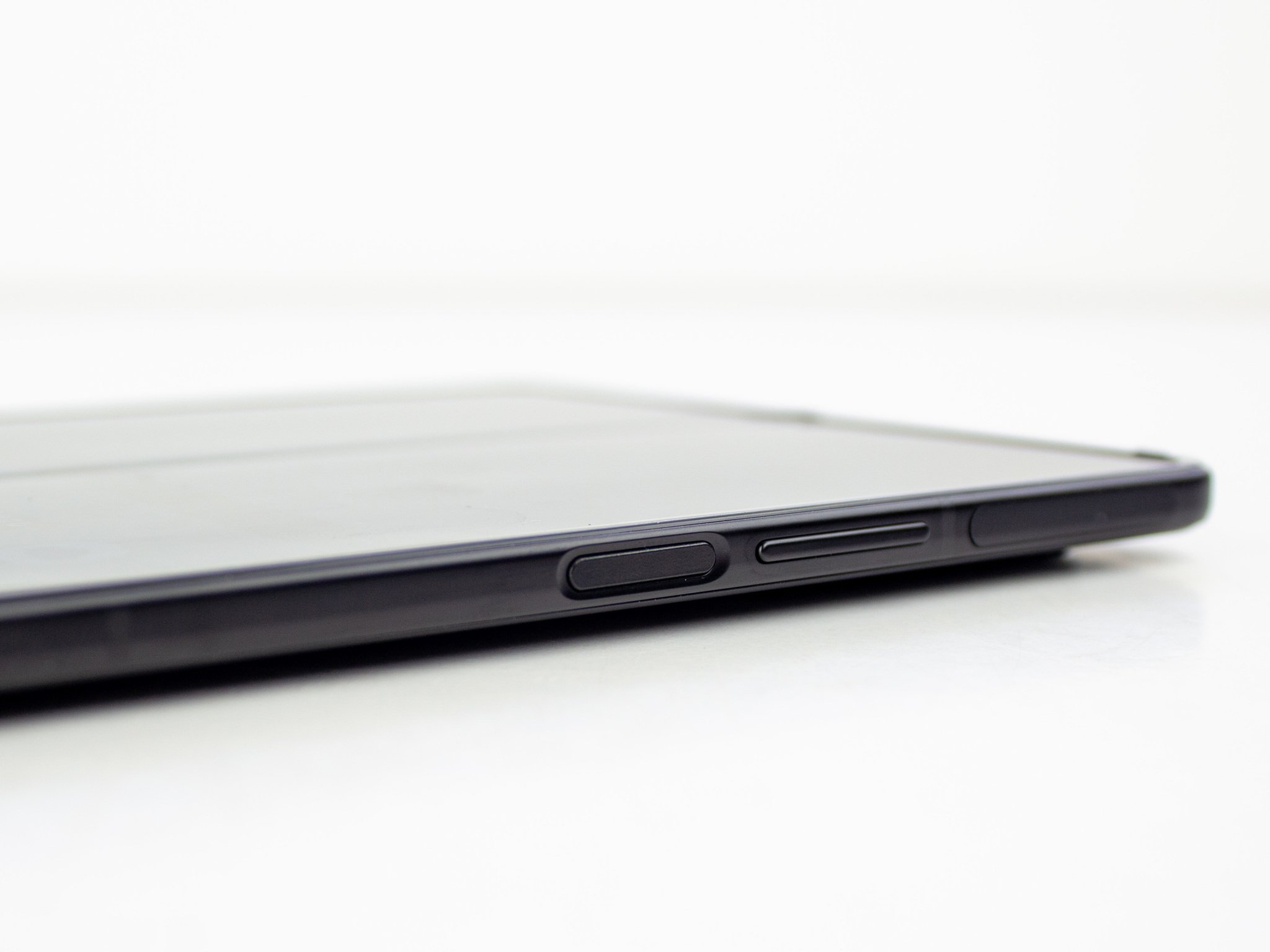
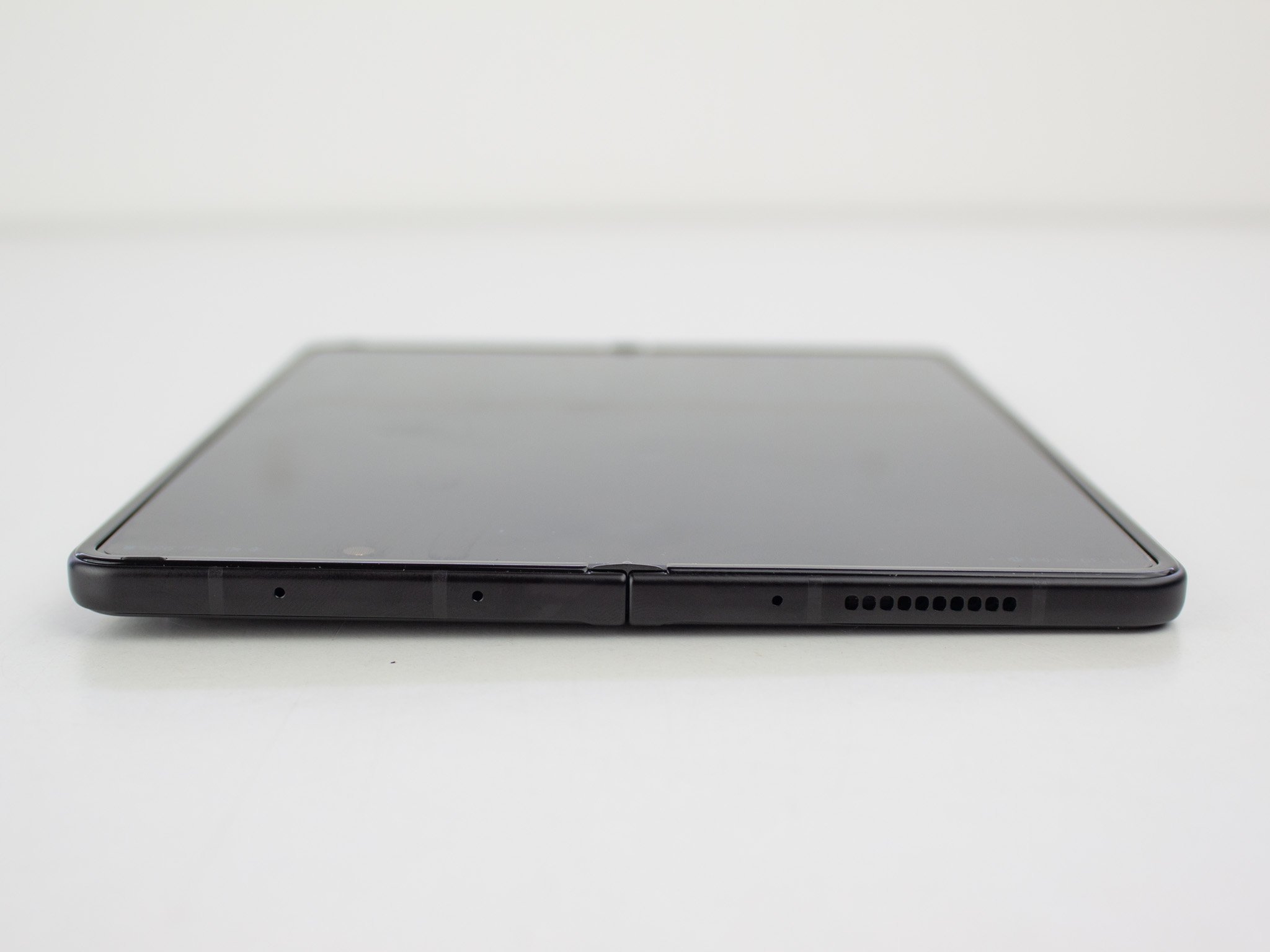

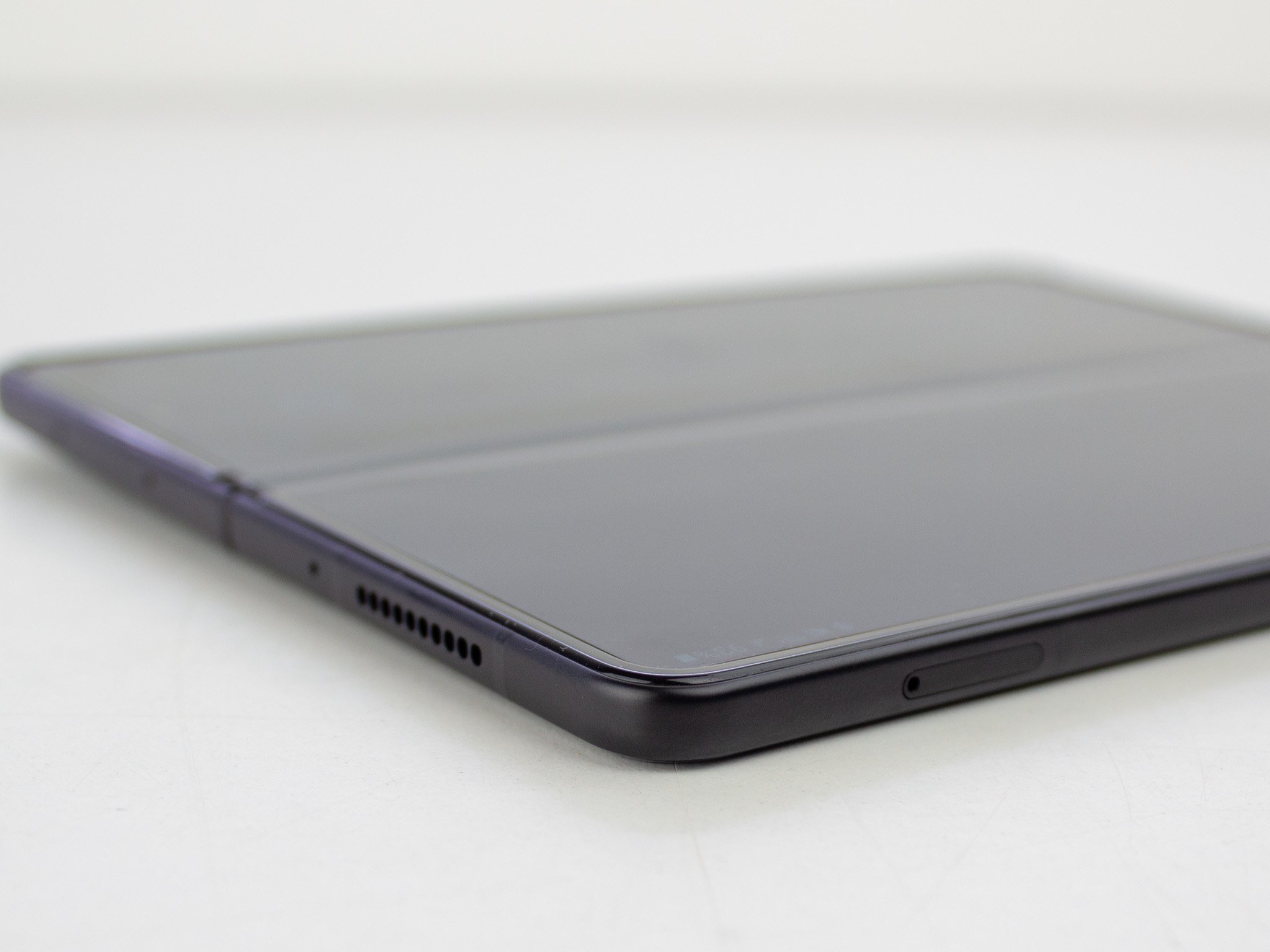
Samsung's decision to stick with a side-mounted fingerprint scanner was a smart one. It's easy to grab the phone with any hand and give that sensor a quick tap to unlock it, no matter how you hold the phone. It's a superior solution to either face unlock or in-screen fingerprint scanners for me.
Another area where the Z Fold 3 crushes the competition is with its stereo speakers. Watching videos on the big screen with the sound cranked up is just sublime. You can feel the bass in your hands and enjoy clear dialog and excellently mixed audio all-around. It's a phenomenal experience that makes the big screen feel like a miniature theater.
While the speakers have improved, the mics themselves are just alright. This is particularly noticeable when using the phone in Flex Mode during a meeting or video call. Because of the way the mics handle noise cancellation, in addition to their placement, leaving the phone on a table or other hard surface creates a hollow, tinny sound for folks listening to you on the other end. Picking up the phone fixes this issue, but I hope Samsung resolves this in a software update.
Galaxy Z Fold 3: Displays
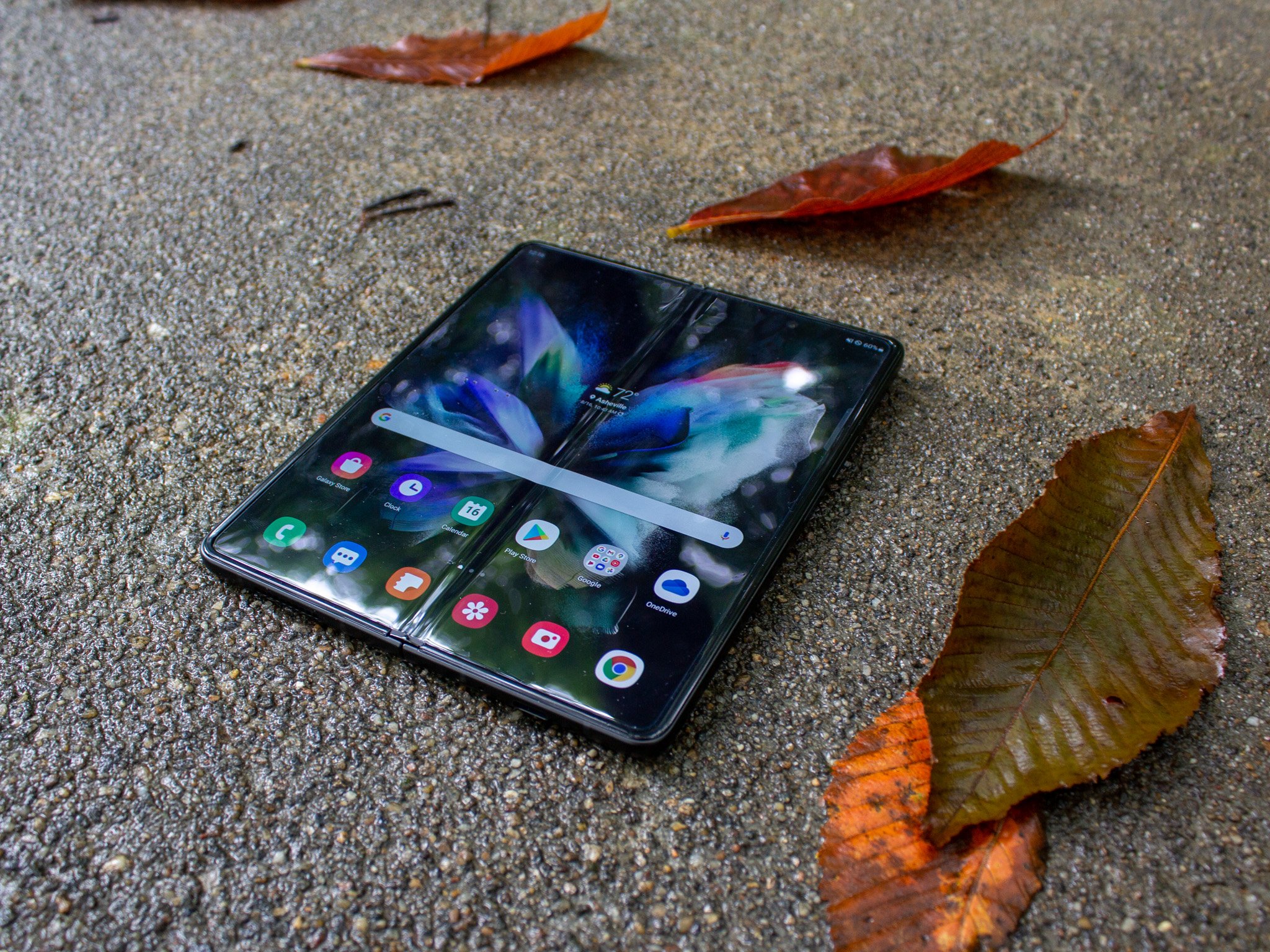
The Galaxy Z Fold 3 ships with two significant display improvements: one you can see and one you can feel. That smaller outer screen is now the same beautifully fluid 120Hz as the inner display, further reducing the friction when moving between the two screens. As you would expect, content on this screen looks stellar, although you'll probably want to limit media consumption on it because of the awkward 22.5:18 aspect ratio.
The new PET screen protectors feel just like glass and don't scratch easily — unlike the Fold 2's.
If you can believe it, the new polyethylene terephthalate (PET) screen protectors that ship with the phone make an even bigger impact on quality than the improved outer screen. Unlike the Galaxy Z Fold 2, these protectors feel like glass and won't scratch easily. They're part of what allows the Z Fold 3 to support the S Pen, which we'll talk about in the section below.
If better scratch resistance and a surface you'll want to touch weren't enough, folks who enjoy using polarized glasses would be happy to know what these screens work just fine with their favorite pair of specs. Conversely, the Z Fold 2's screen would turn into a mess of rainbow colors when viewed with polarized lenses.
The biggest disadvantage of these new screen protectors is that they're not user removable. Over the past six months, the larger inner screen remains completely free from scratches and dents, despite heavy usage during that time.
That smaller outer display's screen protector, however, has several scratches on its surface. There's even a small nick taken out of the top right corner of the protector but, at the least, the display underneath should be just fine.
If any of your Z Fold 3 screen protectors do end up getting damaged or scratched to heck and back, there are alternatives. The best Galaxy Z Fold 3 screen protectors will definitely get the job done, which is great to see given the uncertainty surrounding this when the phone launched.
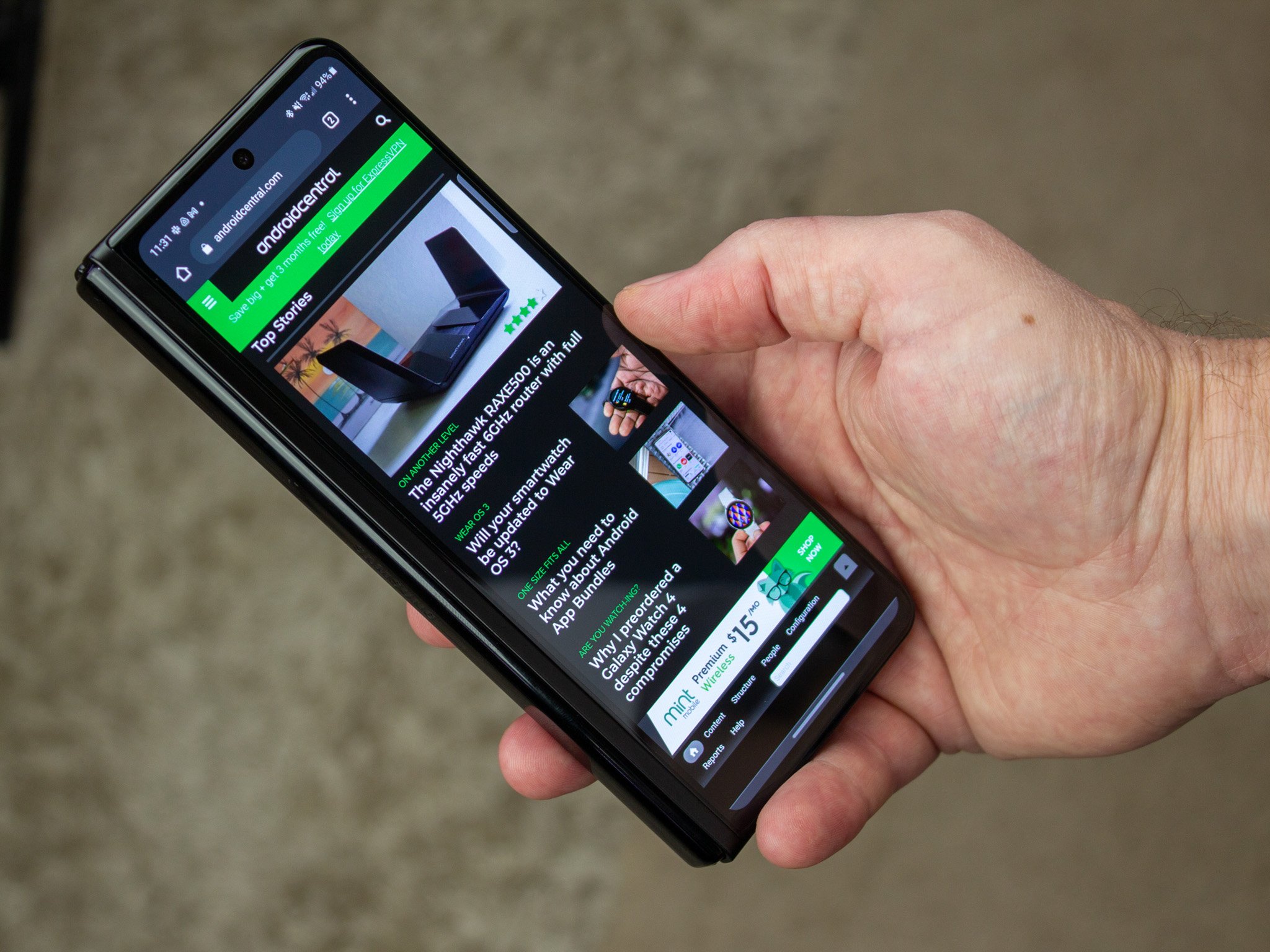
While the difference between the aspect ratios of the screens is pretty massive, it only took me a few days to find an optimal way to use them both individually. The large inner display's aspect ratio, in particular, is great for lazy video viewing. In the YouTube app, for instance, you can watch videos at the entire width of the display without having to rotate the phone at all. Given that it's about as wide as most phones are tall, you're effectively getting the best experience without any effort.
Rotating the display will still give you a larger video to watch and, this time around, no interruption from a punch-hole camera. That was one of my biggest annoyances with the Fold 2's larger screen. The punch-hole camera is still there but is now covered by a unique grid of pixels that's less resolution-dense than the rest of the screen.
The new under-display camera is well hidden while watching full-screen videos.
The result is a sort of mosquito-net effect over the camera that's not quite the ideal solution but, ultimately, is a significant improvement over a giant black hole in the screen. The effect is obvious if you stare straight at it — or look at photos of it — but the camera is nearly invisible to the naked eye while watching videos or playing games.
In fact, there was never a time over the past six months that I even noticed it while consuming content. That, to me, is a huge win for Samsung's design here.
Galaxy Z Fold 3: S Pen support

Waterproofing might be a bigger positive point for most people's daily lives, but Galaxy Note-lovers will want to pay attention to the second huge new feature of the Z Fold 3: S Pen support. The Galaxy Z Fold 3 supports two different types of S Pen: the S Pen Pro and the S Pen Fold Edition. I used the S Pen Fold Edition for this review — a special passive S Pen that requires no charging but lacks Bluetooth support.
This is the Note form factor I've been waiting for since the beginning of the storied history of Samsung's pen-friendly phones.
If you've ever used a Galaxy Note phone, you'll find identical writing features on the Z Fold 3. For example, hovering the S Pen above the screen and clicking the pen's side button will bring up the Air Command list: a set of functions designed to let you quickly scribble down a note, take a screenshot with annotations, or share something on social media. Likewise, holding down this button will change the pen from a writing utensil to an eraser in the Samsung Notes app.
While writing on the new PET screen protector feels identical to the glass of the Note line, being able to hold it like a book while writing lends authenticity to the experience that candy bar-shaped phones never had. There's just something that feels so good about writing in an object that already looks like a book from every angle.

Samsung ensured that the ultra-thin glass wouldn't take damage from the S Pen by equipping the S Pen Fold Edition and S Pen Pro with a tip that automatically retracts when too much pressure is applied. It's a thoughtful choice backed up by a digitizer that detects older S Pen models and displays a warning if you attempt to use them.
To add to that, yes, you can even write on the screen while it's folded at any odd angle. The phone's ability to recognize the difference between pen and touch input means you won't accidentally mark things up with the side of your hand. The S Pen only works on the larger inside screen; you can't jot down a quick note with the phone closed.

Under the hood, Samsung folded in several different types of digitizers to complete the experience. Believe it or not, the WACOM digitizer that enables S Pen support doesn't fold. There are two separate WACOM digitizers on each side, and some software magic makes it impossible to tell that there isn't anything in the crease that the pen touches. A 120Hz refresh rate only further helps drive the illusion that you're writing with a pen and not some old-school stylus.
A 120Hz refresh rate only further helps drive the illusion that you're writing with a pen and not some old-school stylus.
The obvious downside to the Fold 3's design is the lack of a slot for the S Pen to fit in. While this means Samsung can use much, much larger S Pens — as it has with tablets for a while now — it also means that you'll need to remember to take your S Pen with you wherever you go. Unless you grab one of the cases with a dedicated S Pen slot on the hinge, this likely means you're going to forget it at some point.
Folks who want a proper Note-style device with an S Pen holster will have to stick with the Galaxy S22 Ultra this year. Regardless of the lack of holster, this is the Note form factor I've been waiting for since the beginning of the storied history of Samsung's pen-friendly phones.
Galaxy Z Fold 3: Software and performance

Samsung's software has come a long, long way in a reasonably short time. Beginning with One UI's launch a few years back, the new Samsung OS focused on usability, speed, and friendly features that make a difference in the everyday experience. In many ways, this makes the Fold 3 the best phone Samsung has made yet, as it's one of the only actual unique experiences you'll find anywhere in the smartphone market.
In fact, just four months after launching the Z Fold 3, Samsung debuted the phone's first big update: One UI 4. Built upon Android 12, One UI 4 brings a more personalizable version of Android than ever before — which is saying a lot considering how customizable Samsung's flavor of Android has practically always been — and has been available for all Z Fold 3 users since January 2022.
The update was initially supposed to roll out in December but faced a series of delays due to some bugs that were bootlooping some devices. While it's not based on Android 12L — that's the sort of Android 12.1 that Google designed to work best for foldables and devices with large displays — we expect that some of Android 12L's new features will make their way to the next One UI update on the Z Fold 3.
As it stands, a lot of what Google built into that OS update was already pioneered by Samsung, anyway. In many ways, the Android 12 One UI 4 update for the Z Fold 3 was a bit of a disappointment since many of the new theming features Google added in Android either didn't make their way to the first One UI 4.0 release.
Those new features are found on One UI 4.1, which launched with the Galaxy S22 series. New theme features include wider color palette support and the ability to automatically theme supported apps system-wide. On One UI 4.0, only Samsung apps receive colors chosen from the system color picker.
In all my time testing the Z Fold 3, I never noticed anything short of the very best performance I've seen out of any phone. I was regularly blown away by how many apps the Fold 3 keeps in memory at a time. This phone is a multitasker's dream come true in every possible way.
In many ways, though, it feels like Samsung held too much back in the out-of-the-box configuration. The Galaxy Z Fold 3 can do so much compared to other devices, a fact that doesn't just revolve around the powerful Snapdragon 888 processor or the liquid-smooth 120Hz screens, but the device's design as well. You'll just have to release its built-in restraints first.
All the new software features are disabled out-of-the-box and hidden pretty deep in the settings.
The Fold 3 can multitask like no other phone out there. The giant 7.6-inch screen inside is quite literally the size of a smaller tablet and can comfortably fit three apps on-screen at once. Apps can display more information at once — like the list of conversations in the messaging app or large previews of pictures taken in the camera app — and most apps can comfortably fit side-by-side without feeling cramped. Each half of the Fold's screen is the size of a standard phone, anyway.
That slide-out sidebar can now be locked into place much in the way you would expect on a desktop or laptop dock, giving you quick one-touch access to your most-used apps and app pairs. Apps that don't play nicely with the big-screen mode or multitasking view can now be resized to any aspect ratio you want or even floated above currently-running apps.
The problem is that none of these tools are enabled by default. Instead, you'll have to go into the settings menu, slide down to advanced features, jump into Samsung Labs, and will allow them individually. Surprisingly, One UI 4 didn't do much to improve this. More features than ever are available to users — including even more powerful options in Samsung's Good Lock suite of apps — but most of them aren't enabled by default or available without having to download additional apps.
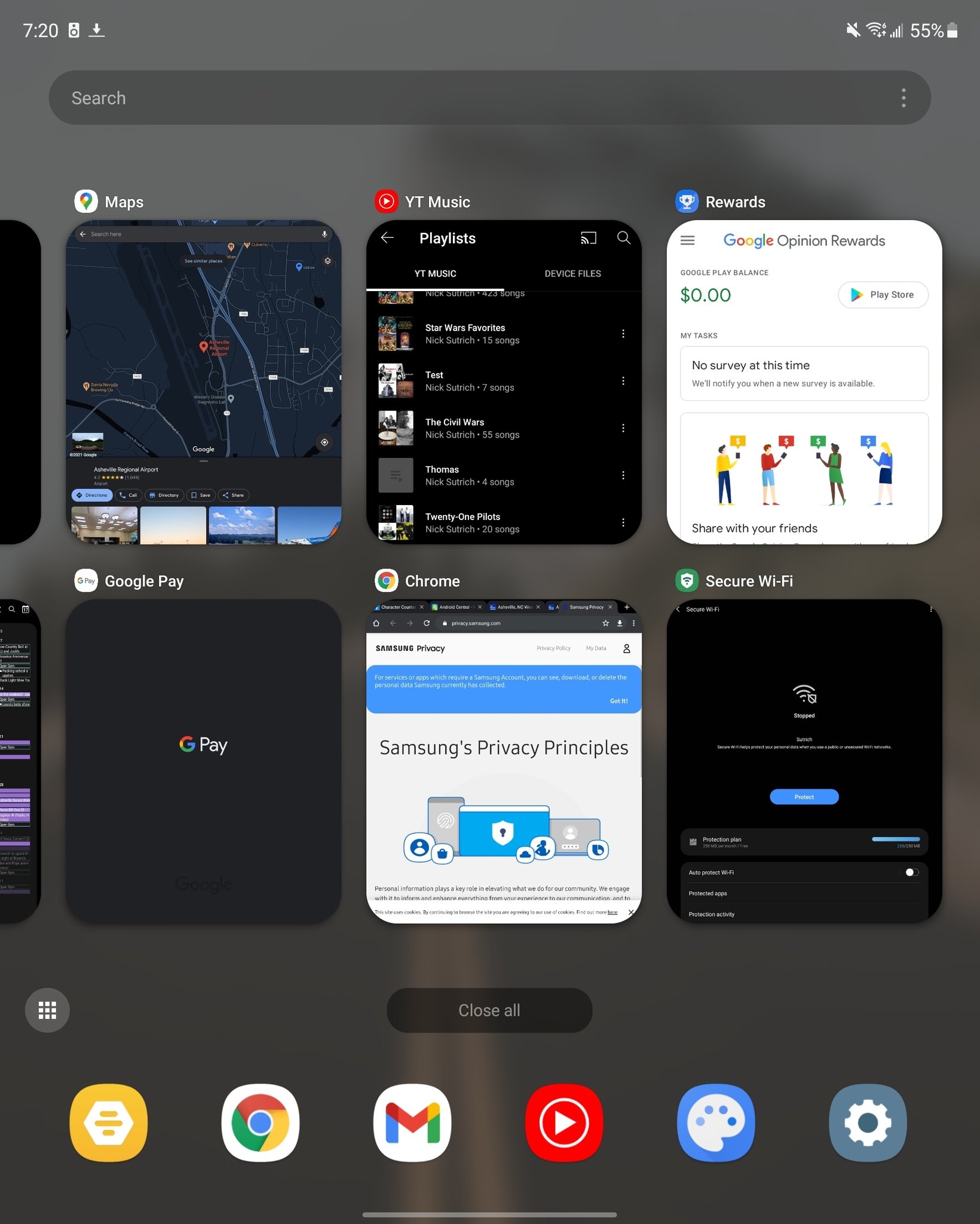

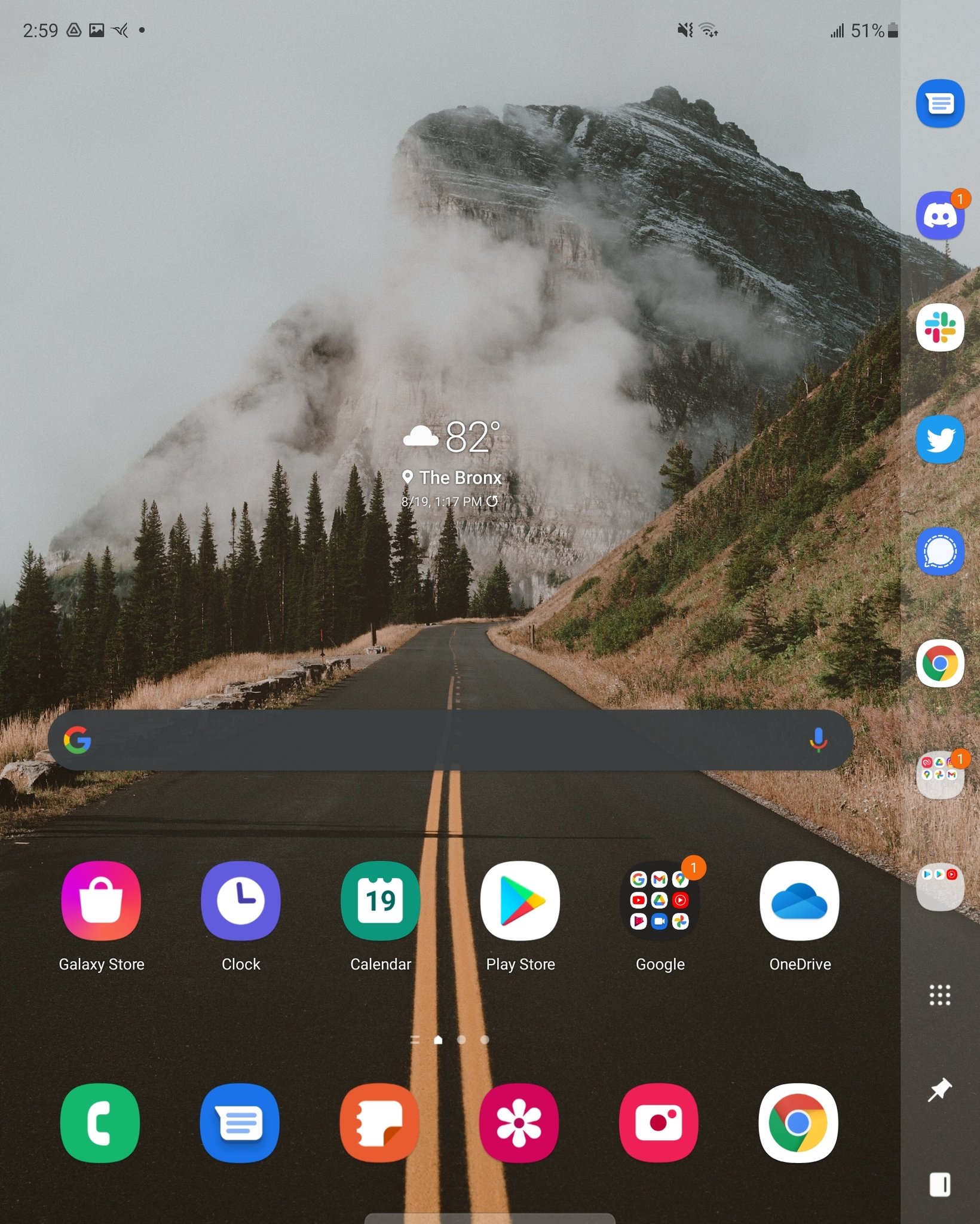
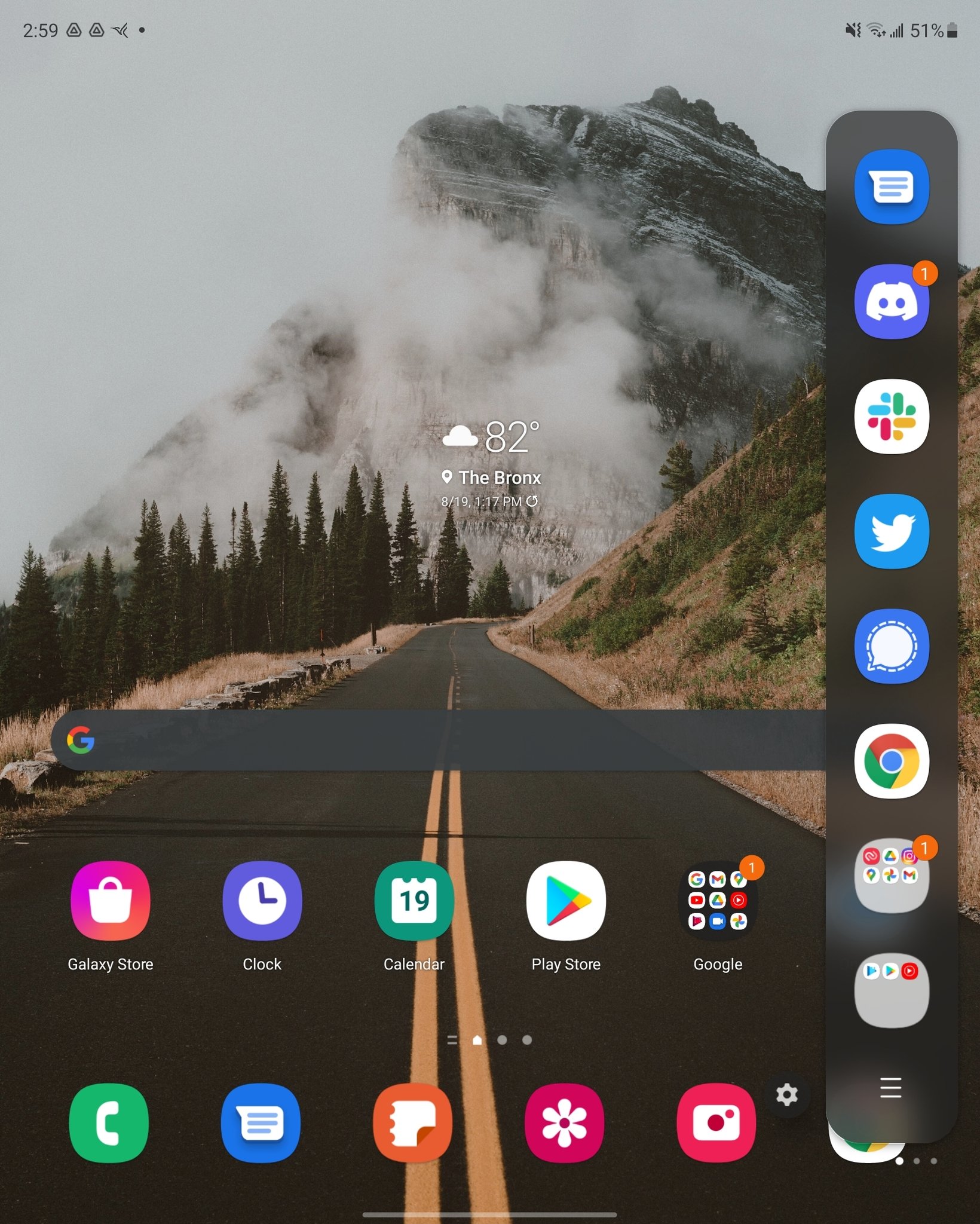
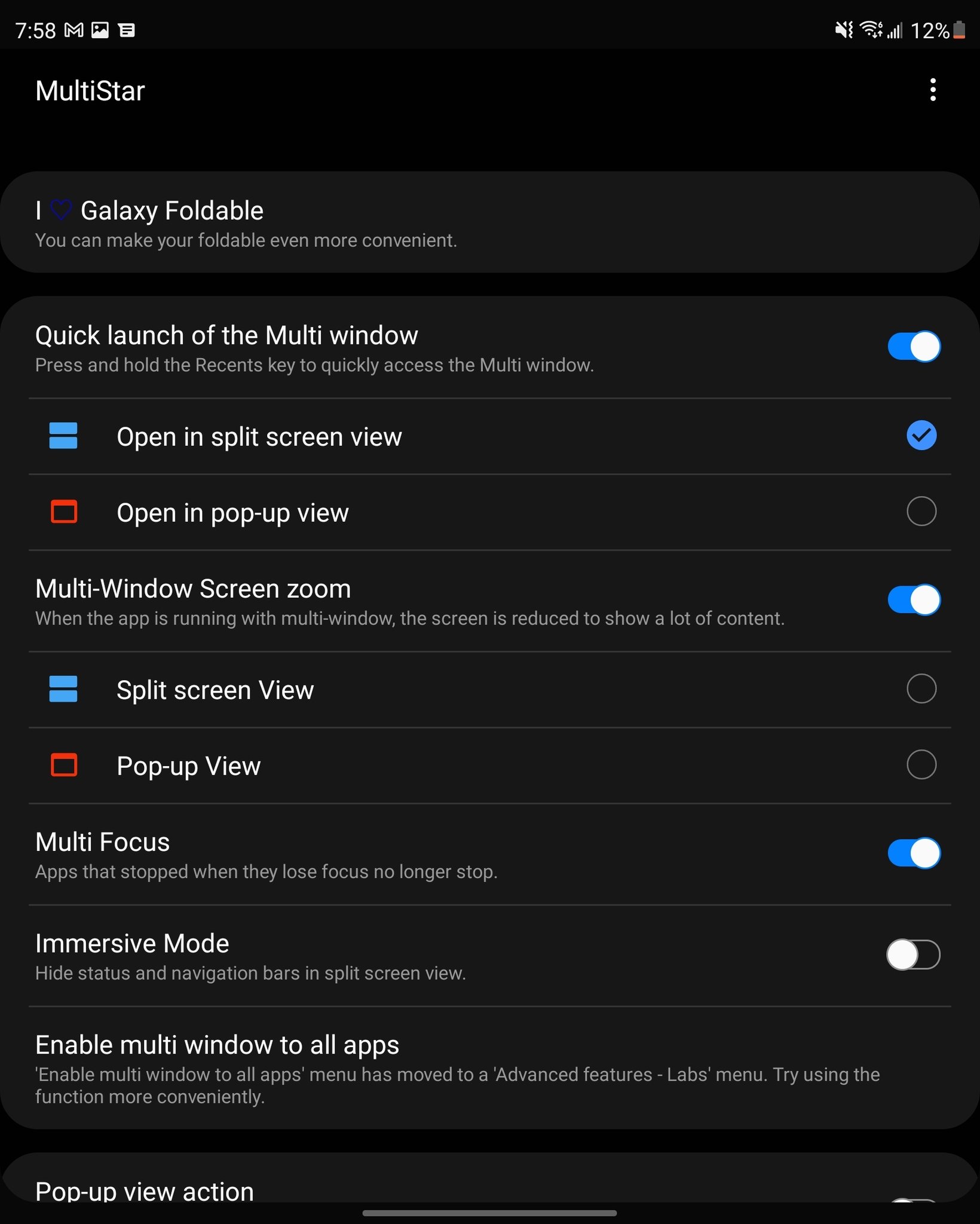
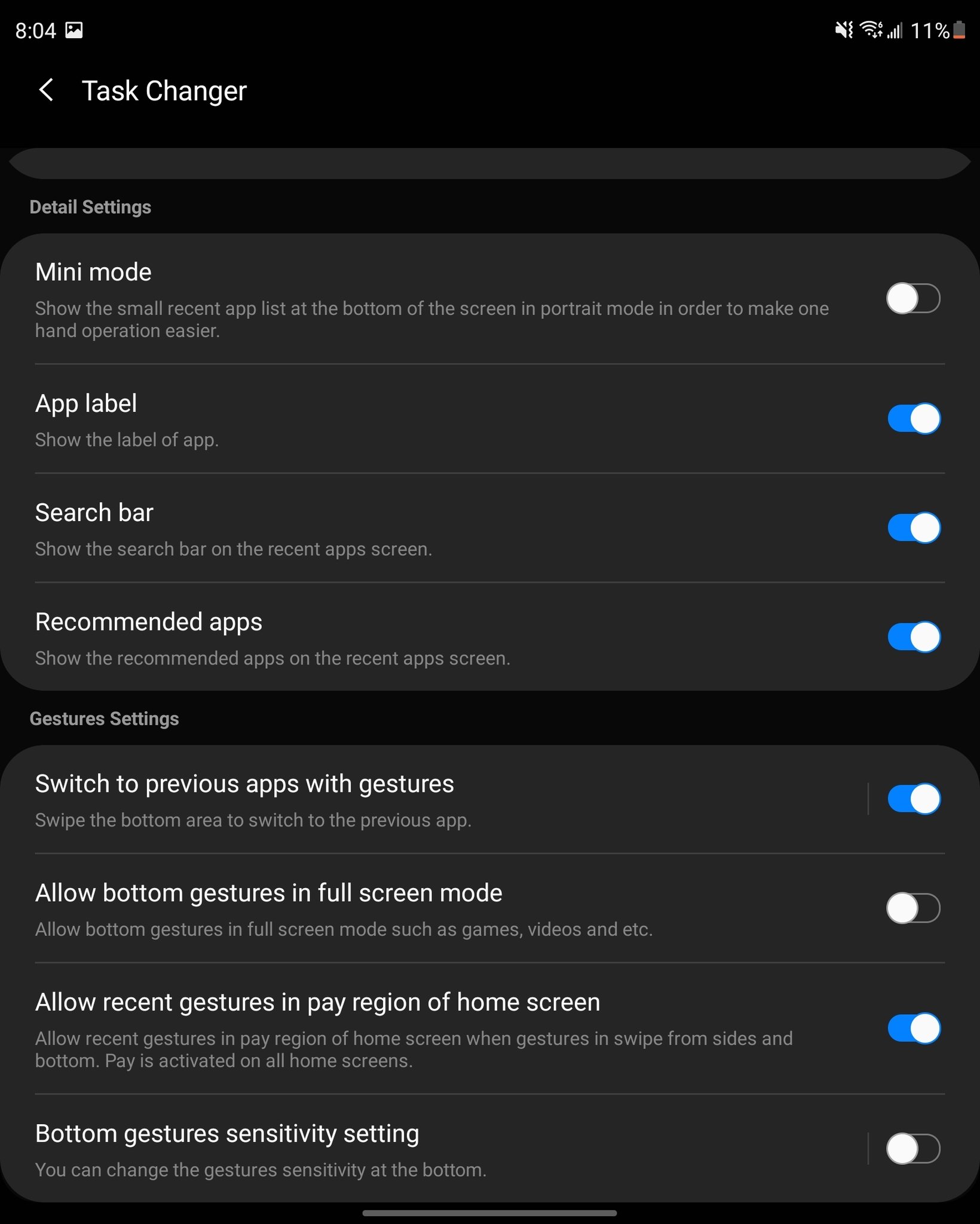
To me, this was a huge mistake on Samsung's part. Yes, Samsung buried these features because of years of heckling over its overly complex UIs and complicated settings menus. The problem is that, for the most part, the Galaxy Z Fold 3 isn't a phone for standard users and, more importantly, isn't just another phone. It's a multitasking beast that should have had all these features enabled out of the box.
Going along those lines, you'll still need to download the Good Lock app from the Galaxy App store to take full advantage of this phone's screen real estate and multitasking power. In Good Lock, you can enable quick gestures for pulling up the multitasking Overview screen and even prevent videos from stopping if they're not in the "active" window. To simplify that, videos will, by default, stop playing if they're in split-screen or a floating window when you navigate away from them to send a text message.
The more you dig, the greater reward you'll reap. It's a plethora of incredible features just waiting to be found.
Additionally, having a giant 7.4-inch screen and only one app tile on screen at the time in Overview is an incredible waste of screen space. Instead, jump into Good Lock's Home up section, change that to a grid of six apps if you really want to multitask, and thank me later. Good Lock also enables a significant amount of UI customization that seems like it should be standard fare in the Display section of system settings; even Google put that setting in the forefront of Android 12.
Here's the bright side about every one of these things: all of them can be done with a few settings changes. That's it. They're all here and ready to be used as soon as you're ready to dig for them. In many ways, that follows the rest of the Galaxy Z Fold 3 experience: the more you dig, the greater reward you'll reap. It's a plethora of incredible features just waiting to be found. I just wish they weren't so hidden, as I'm betting plenty of people will never realize the phone's full potential.

I've never been much of a mobile gamer in the past, as I'm a stickler for playing games with a button-laden controller. Since I've had the Z Fold 3, however, I've really jumped into the mobile space and realized just how much I love having a portable console that I can take anywhere. For me, the Galaxy Z Fold 3 — when paired with something like a GameSir X-2 controller — is the ultimate portable gaming form factor.
While TVs have moved from the 4:3 aspect ratio of the tube days to a 16:9 aspect ratio we expect from flatscreen displays, smartphones have gone even wider in recent years. Most smartphones sit somewhere around the 20:9 ratio, meaning they're extremely wide and short when docked in a controller. This is awkward for some games, as it really kills the vertical viewing space.
The Z Fold 3, on the other hand, offers an incredibly big, beautiful aspect ratio that's much closer to 4:3 than anything. When playing games like Fortnite, this extra vertical space makes all the difference in the world. This, combined with incredible performance all around, has kept me using the Z Fold 3 as my main mobile gaming station since its debut in August. I absolutely love it and never want to go back.
Galaxy Z Fold 3: Battery

If you thought a giant phone meant a giant battery, prepare to be disappointed. The Galaxy Z Fold 3 actually saw a 100mAh reduction in battery size compared to the Z Fold 2, which makes sense when you consider that the Fold 3 is slightly thinner than the Fold 2. In my estimation, a full day's worth of use is something you'll struggle to achieve when using the phone to its full potential, and that's really a bit of a shame.
It's not that the battery life is bad; it's just that it's not very good. It's not a big enough negative to make the list of cons in the way battery life held back phones like the Pixel 4, but there's little doubt that some power users will be searching for a charger before the day ends.
Gamers will definitely notice a substantial battery drain when running graphically-intensive games on the Z Fold 3 — especially when using that bigger display. I can get 2-3 hours of solid playtime before needing to charge, which means the Z Fold 3 has roughly the same battery life as a Nintendo Switch when used primarily for gaming.
It's not that the battery life is bad; it's just that it's not very good.
Given the huge improvements in charging times of phones over the past few years, there was a genuine expectation that Samsung would pull a big move to faster-charging speeds with the Fold 3. Sad to say, charging rates are no faster than they were on the Z Fold 2. Wireless charging at 10W is a bit on the slow side, but in all honesty, the 25W wired charging is more than adequate for a quick top-up at any time of the day. Just a shame that there's no 25W charger in the box.
Galaxy Z Fold 3: Cameras

Little difference exists between the Galaxy Z Fold 2 and the Z Fold 3's cameras or battery size. On paper, they're identical — sans the inside camera on the large screen — which means the software is the only place where Samsung made improvements this year. Given that Google has been working magic with an ancient camera sensor on its Pixels for the last four years, software upgrades shouldn't be discounted.
Photos from the new under-display camera inside the Fold 3 simply look horrible.
Before we delve into the improvements, let's cover that new camera on the larger inside display. From a resolution standpoint, it's a pretty big downgrade. At 4MP, it's a 6MP resolution reduction from the Z Fold 2, but there's a good reason for it. With the same physical sensor size, Samsung could cram much larger pixels inside the area since there aren't so many of them. Large pixels let it capture more light in low-light conditions — a serious issue with last year's inside camera.
It's just a shame that the combination of a lower resolution sensor and the under-display tech made regular photos look this bad. There's no way to put it any differently: photos on this inside camera are horrible, and the sensor still struggles with dark environments despite the upgrade. Simply put: only use this camera for video calls.
Considering that the rest of the hardware hasn't changed, I went into this review expecting to be regularly disappointed with the camera experience on the Galaxy Z Fold 3, given that the Fold 2 isn't exactly a star player in the camera field. Instead, what I came away with was a level of trust in Samsung's camera software smarts that I simply hadn't expected. The Fold 3 delivers a genuinely impressive experience every time you use the camera, and that's a great thing considering the doubts that seem to be harbored over its camera.
Samsung's camera software is shockingly smart in every way, and its speed trounces the performance of most phones, including Pixels. I caught a picture of a black bear wandering through my neighborhood in a split second with the Fold 3's camera, whereas I'm confident that my Pixel 4 XL — a phone that I've stopped using since I originally published this review — would still have been loading the viewfinder by the time the bear disappeared.
Other times, I found myself surprised at just how many useful modes Samsung packs into its camera software. Samsung's intelligent scene detection suggests the right mode to switch to at the single press of an on-screen button, so modes you'd typically ignore get plenty of use. Everything from switching to food mode to scanning the tomato sauce recipe I took a picture of for my father — complete with text extraction as soon as I shot the photo — regularly blew me away.
I had my doubts but came away with a level of trust in Samsung's camera software smarts that I simply didn't expect.
It's snappy, responsive, smart, and pumps out some really impressive pictures despite hardware that falls short of impressive shooters like the Galaxy S21 Ultra. You won't get the impressive zoom levels of that phone — or any of the rest of the Galaxy S21 line, for that matter — but the Z Fold 3's regular and ultra-wide angle cameras are simply superb. Even the front-facing camera on the small screen is truly excellent and is a heck of a lot easier to use than the inside camera, too.

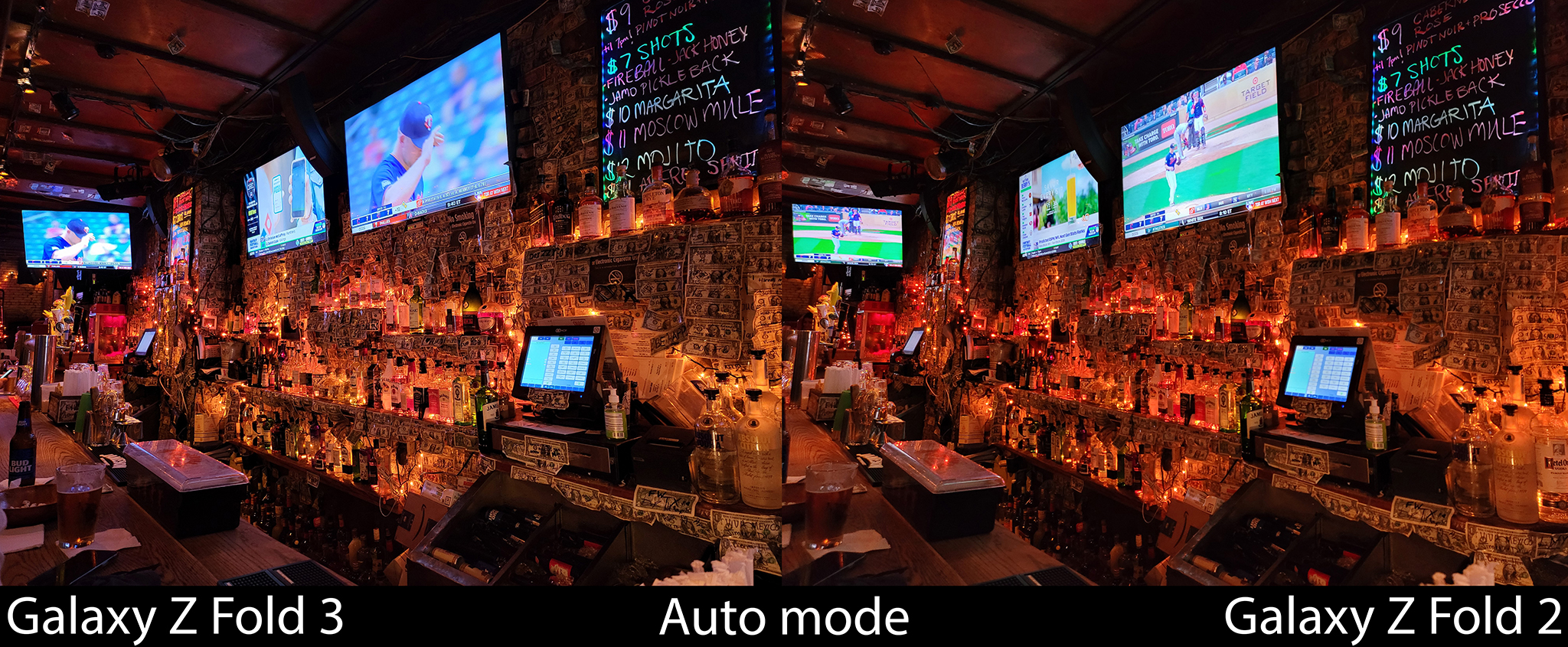
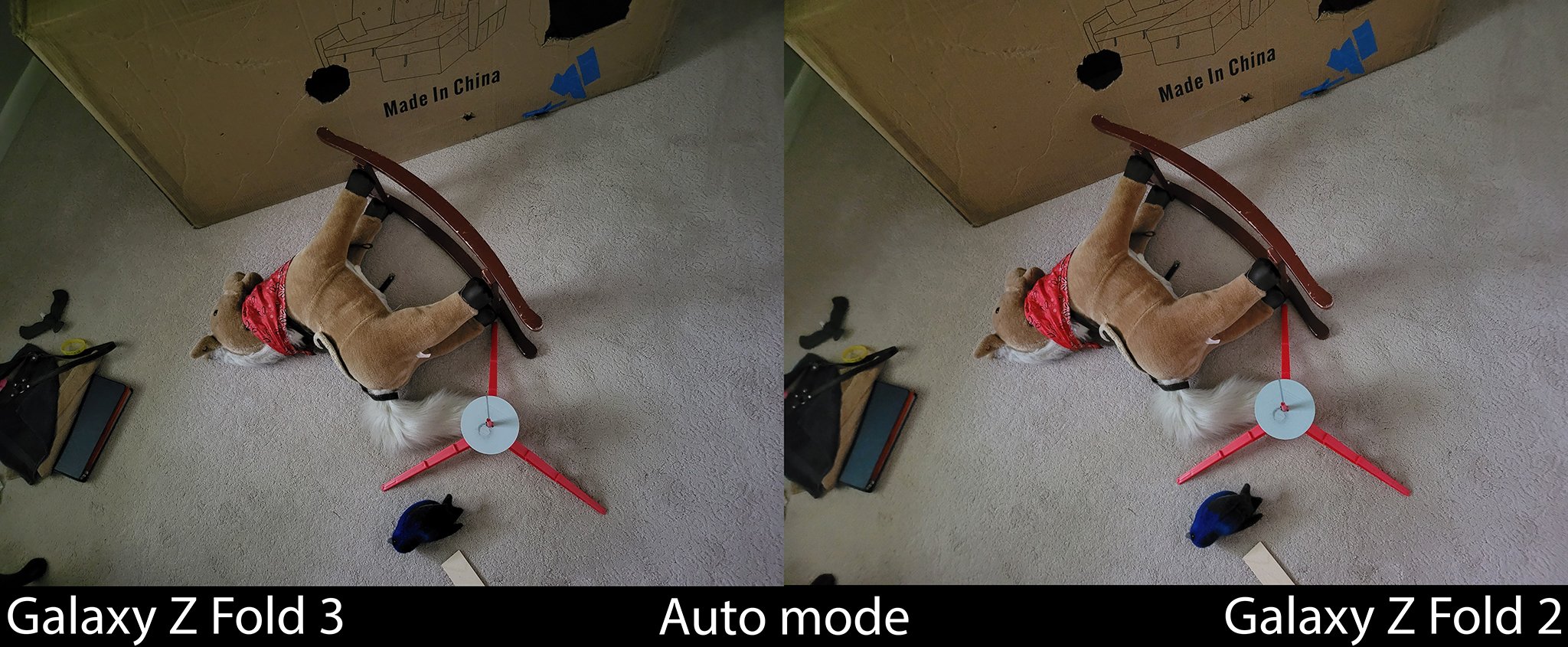
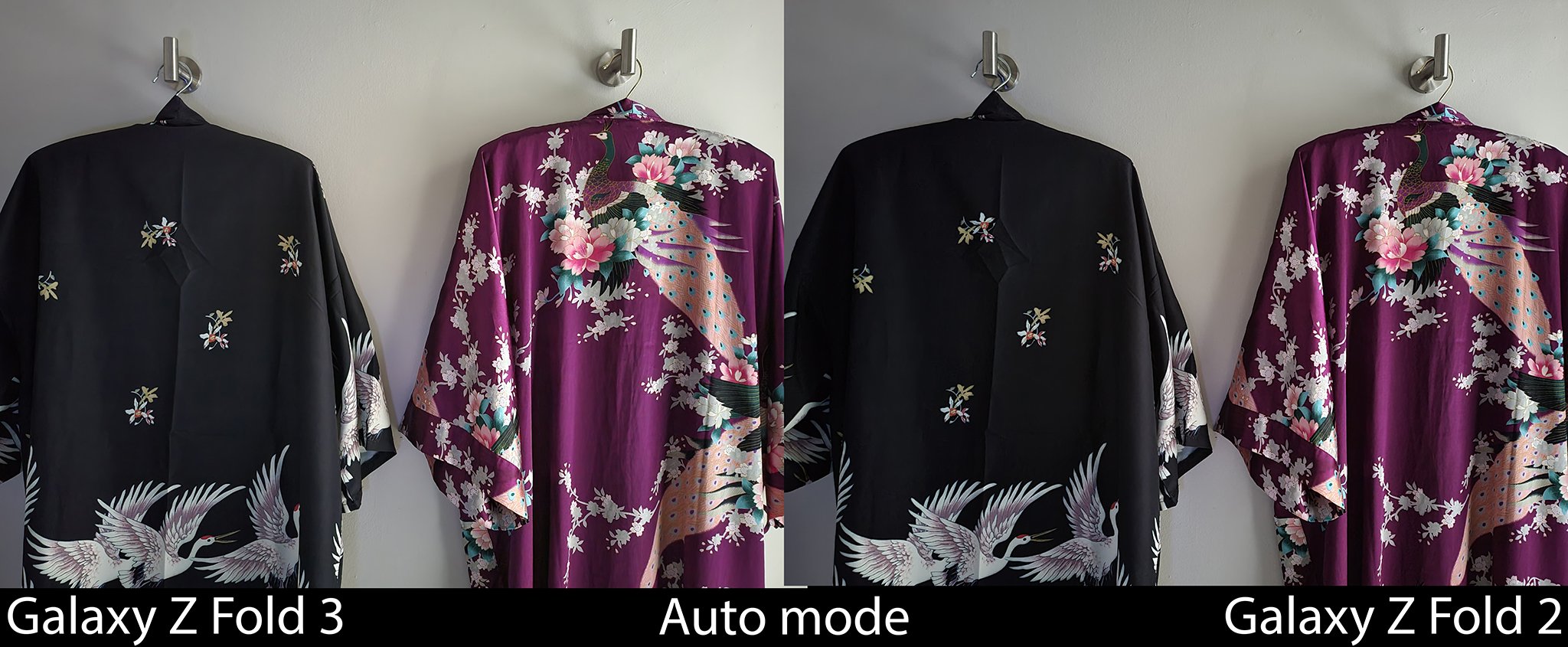


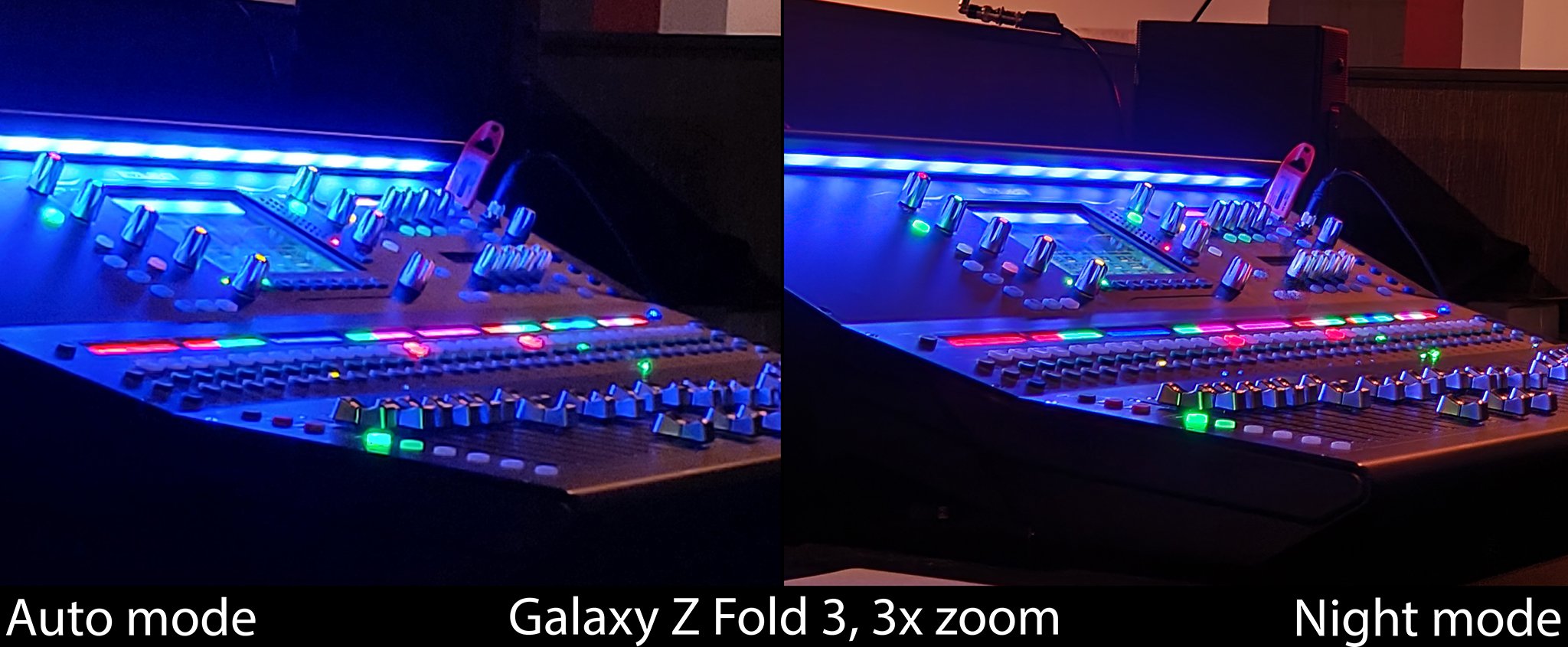
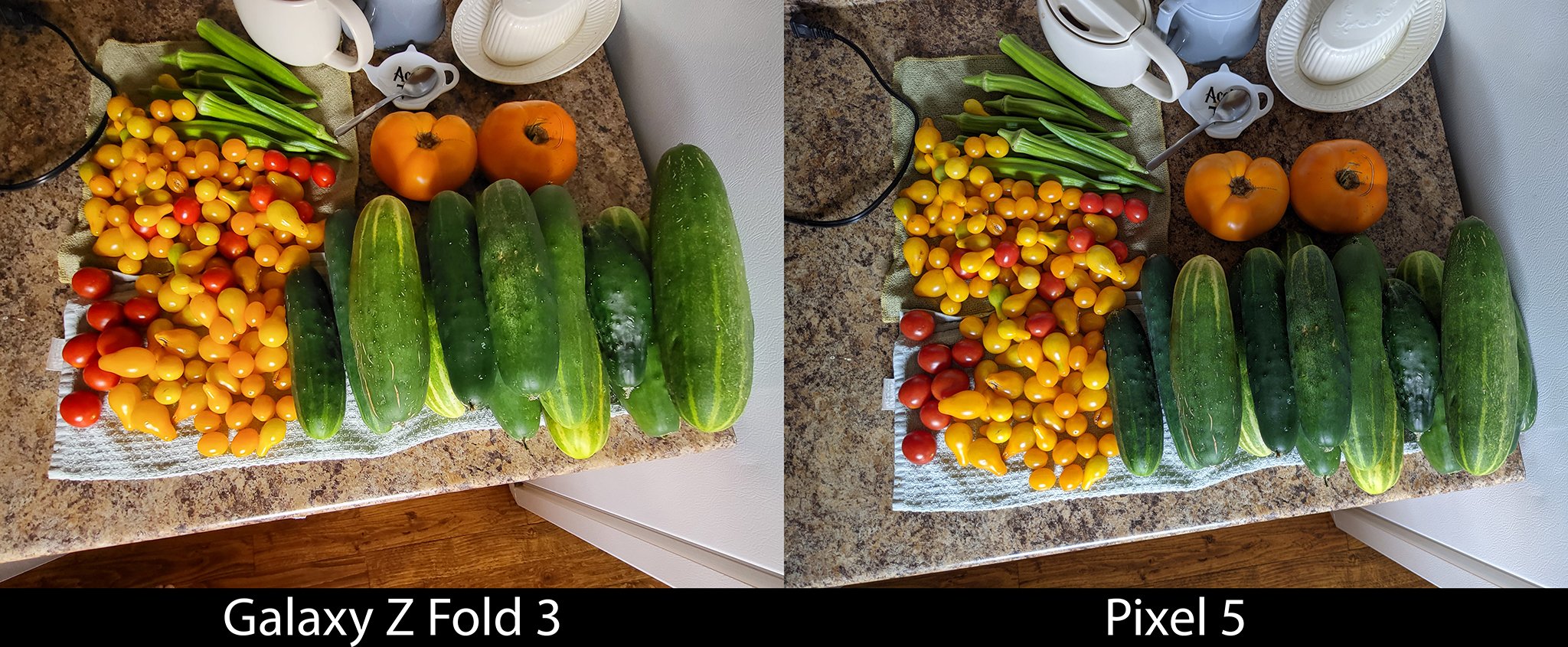
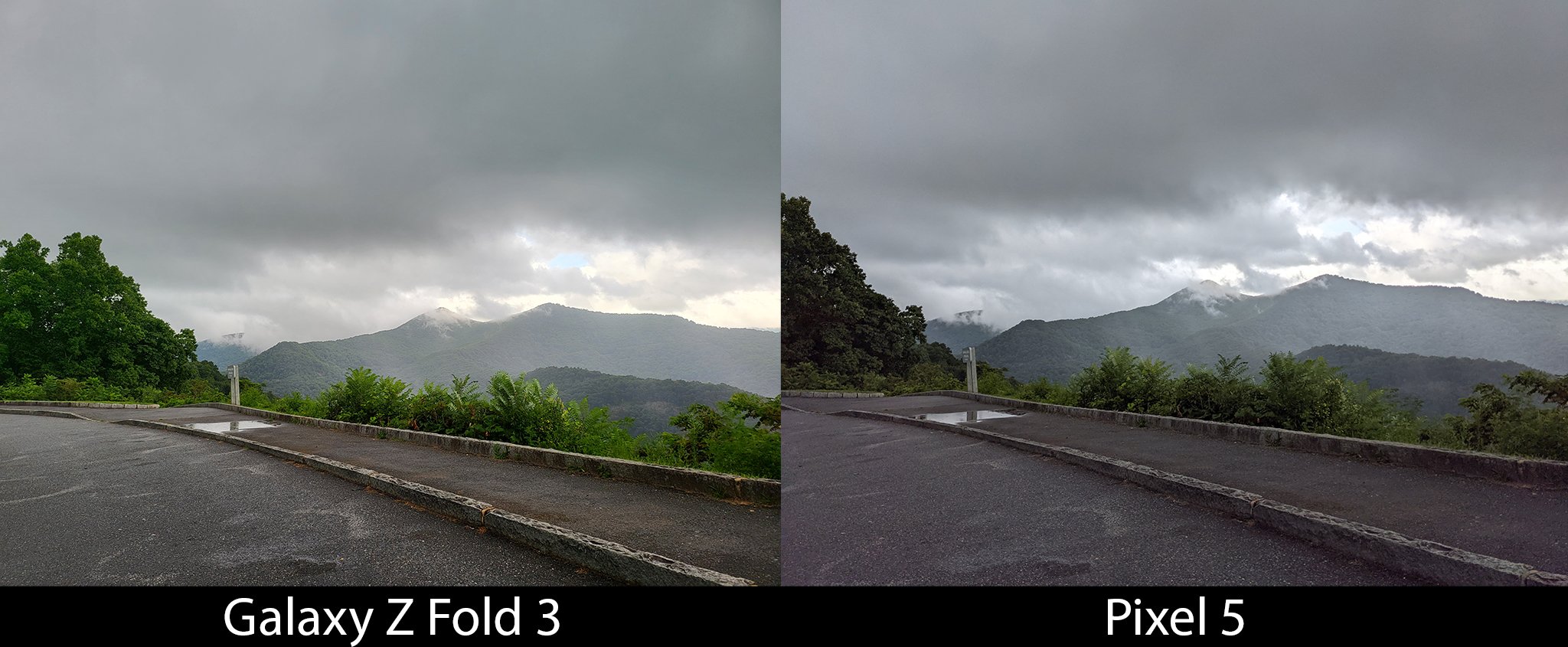
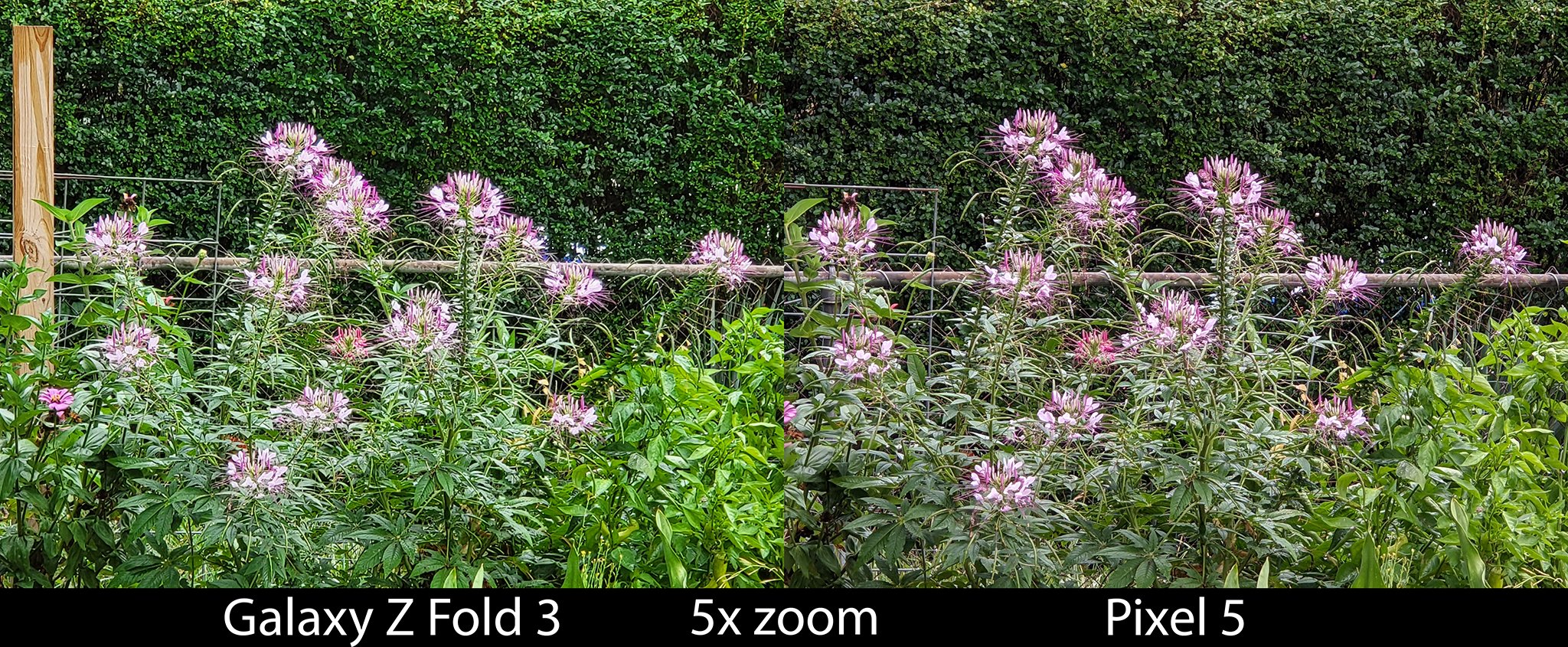
Photo quality is what you would expect from a Samsung phone in many ways, although the company has improved its processing a bit over the years. If you've ever used a Samsung phone, you know what to expect. Bright photos, punchy colors, great dynamic range, and a penchant for over-sharpening when HDR kicks in. Not much has changed there. Dynamic range is better than it has been in the past, though, even if only slightly.
The main camera is a little bit wider than other phones, which helps take in more of any scene but also creates a bit of fringing and lens distortion on the edges of shots. This is particularly noticeable when trying to take photos of anything less than a foot away.
Low light performance impressed me the most, though. Auto night mode ensures that you get the best shot every single time — a godsend in many situations where auto mode would have produced a low fidelity shot — and easily goes toe-to-toe with any flagship you'll pit against it. Compared to the Z Fold 2, the Z Fold 3's camera produced more detailed shots in dark conditions, complete with better overall balance and first-rate dynamic range, even without switching to night mode.
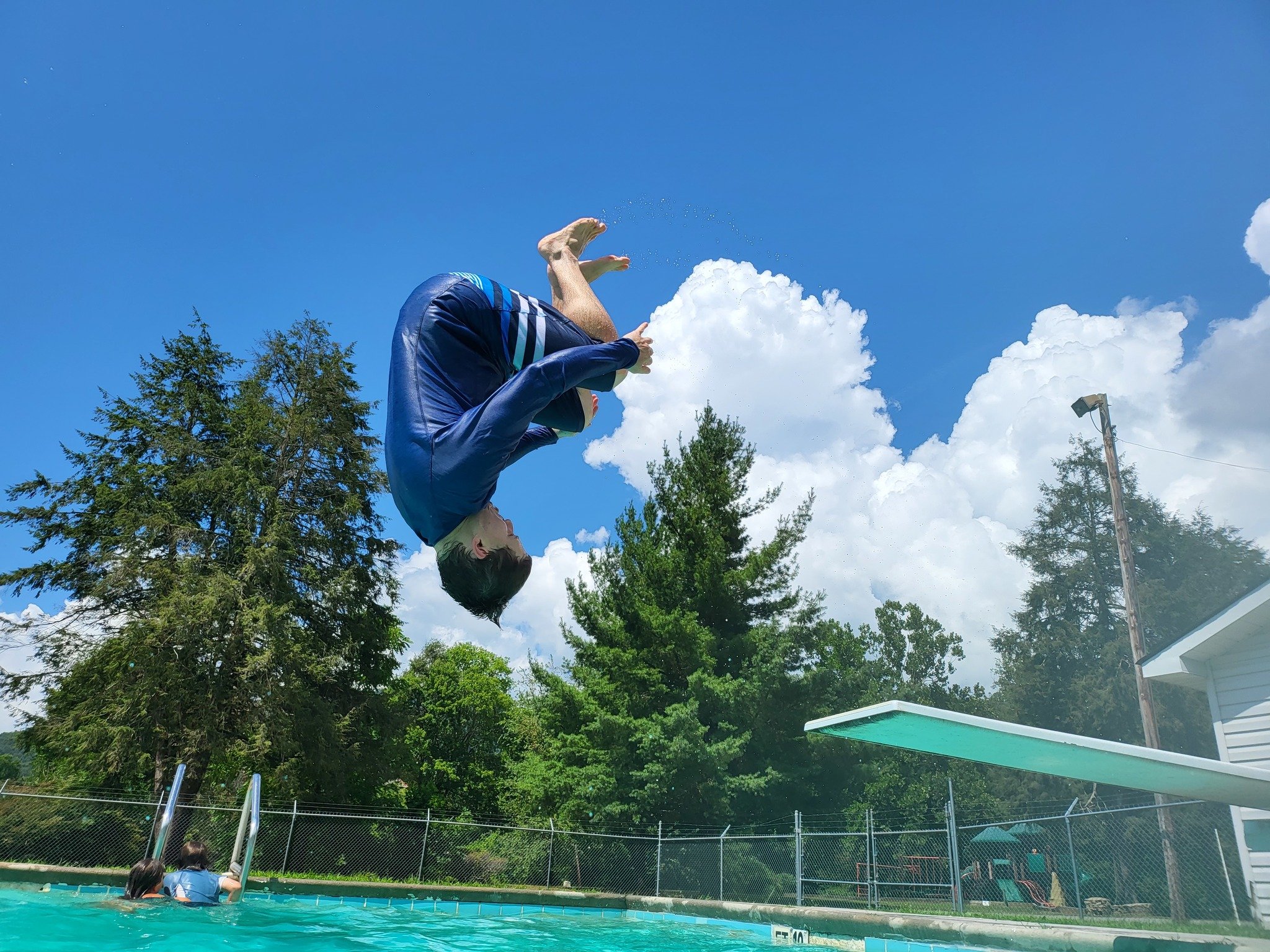
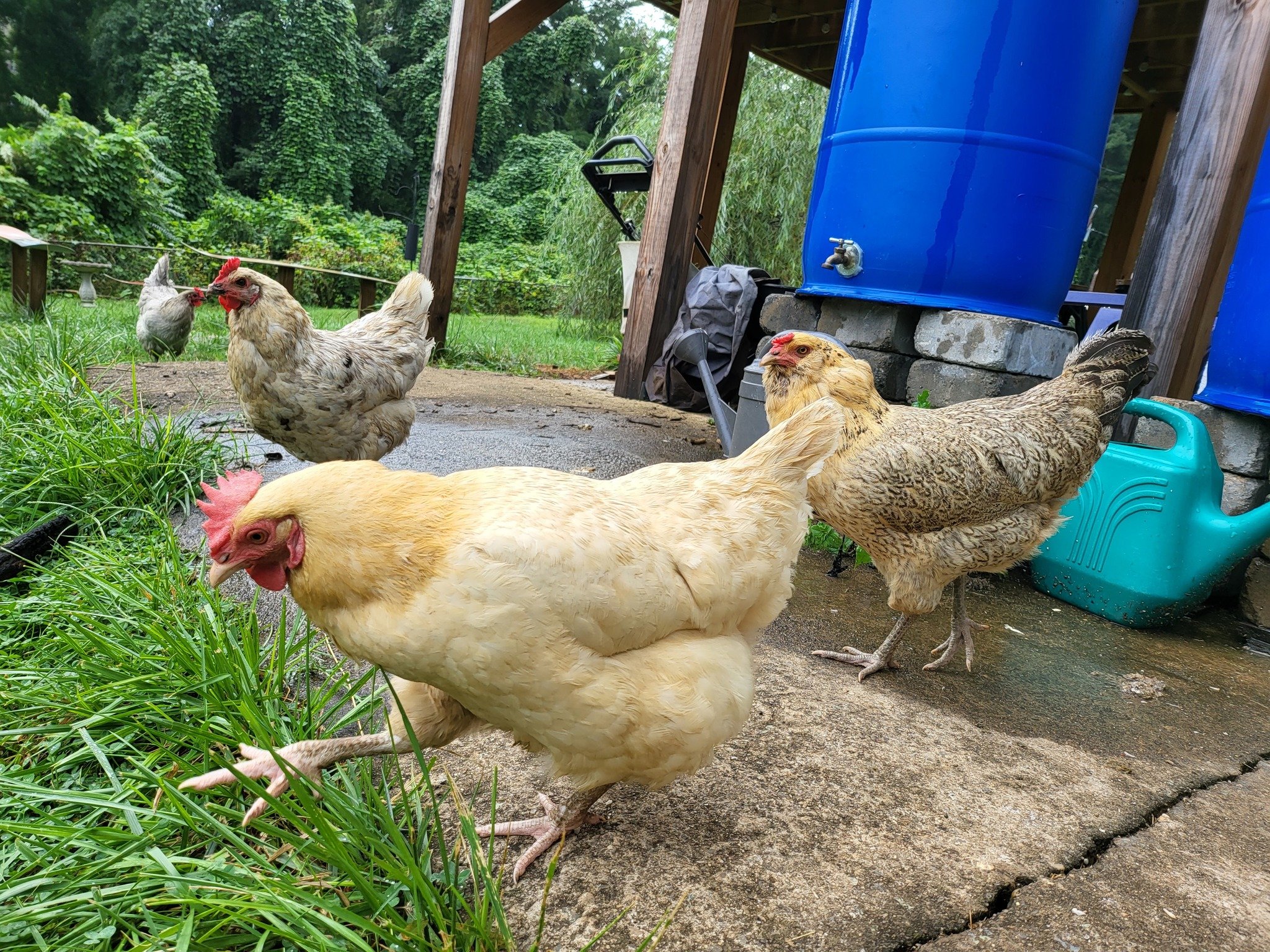
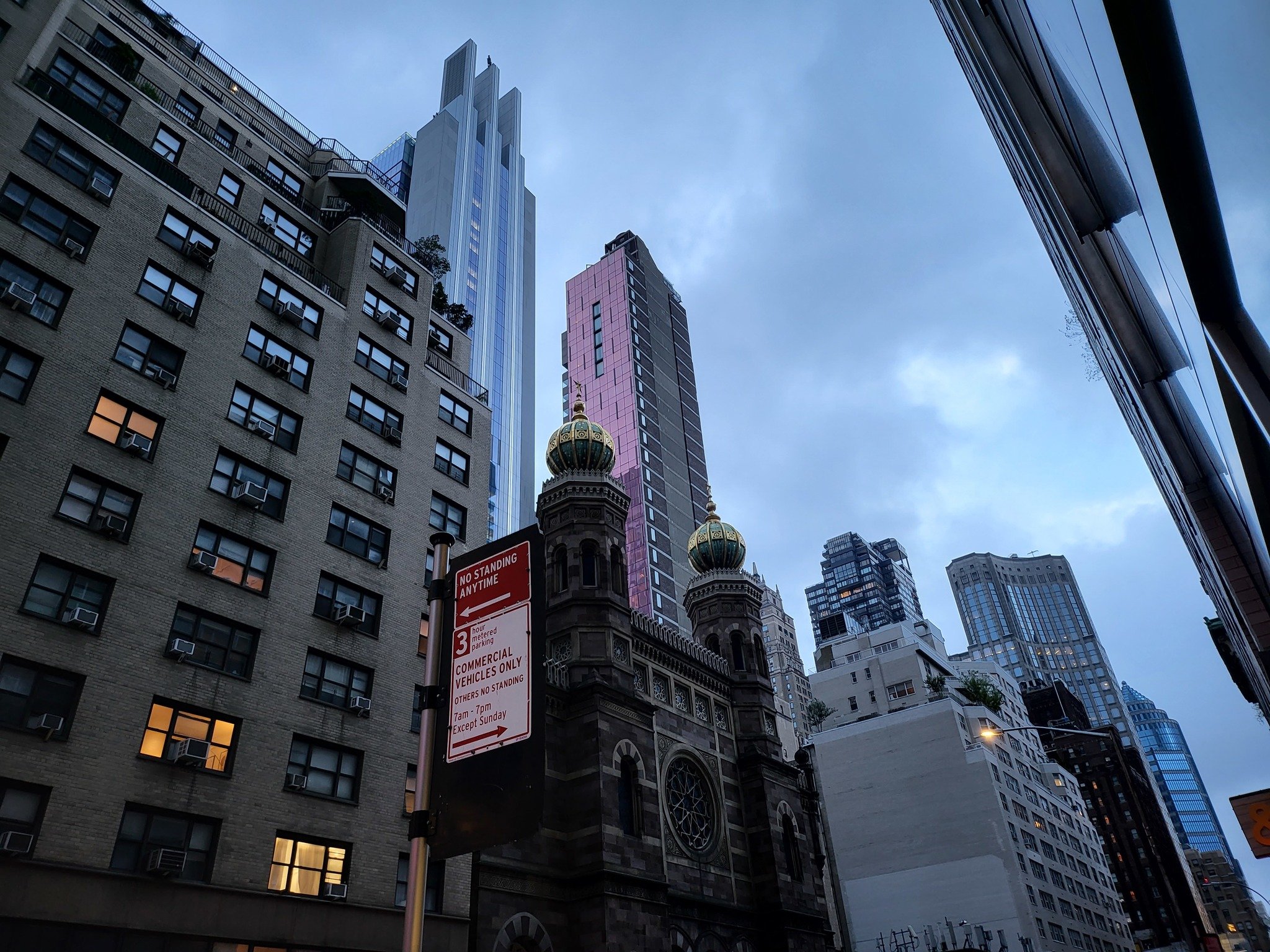
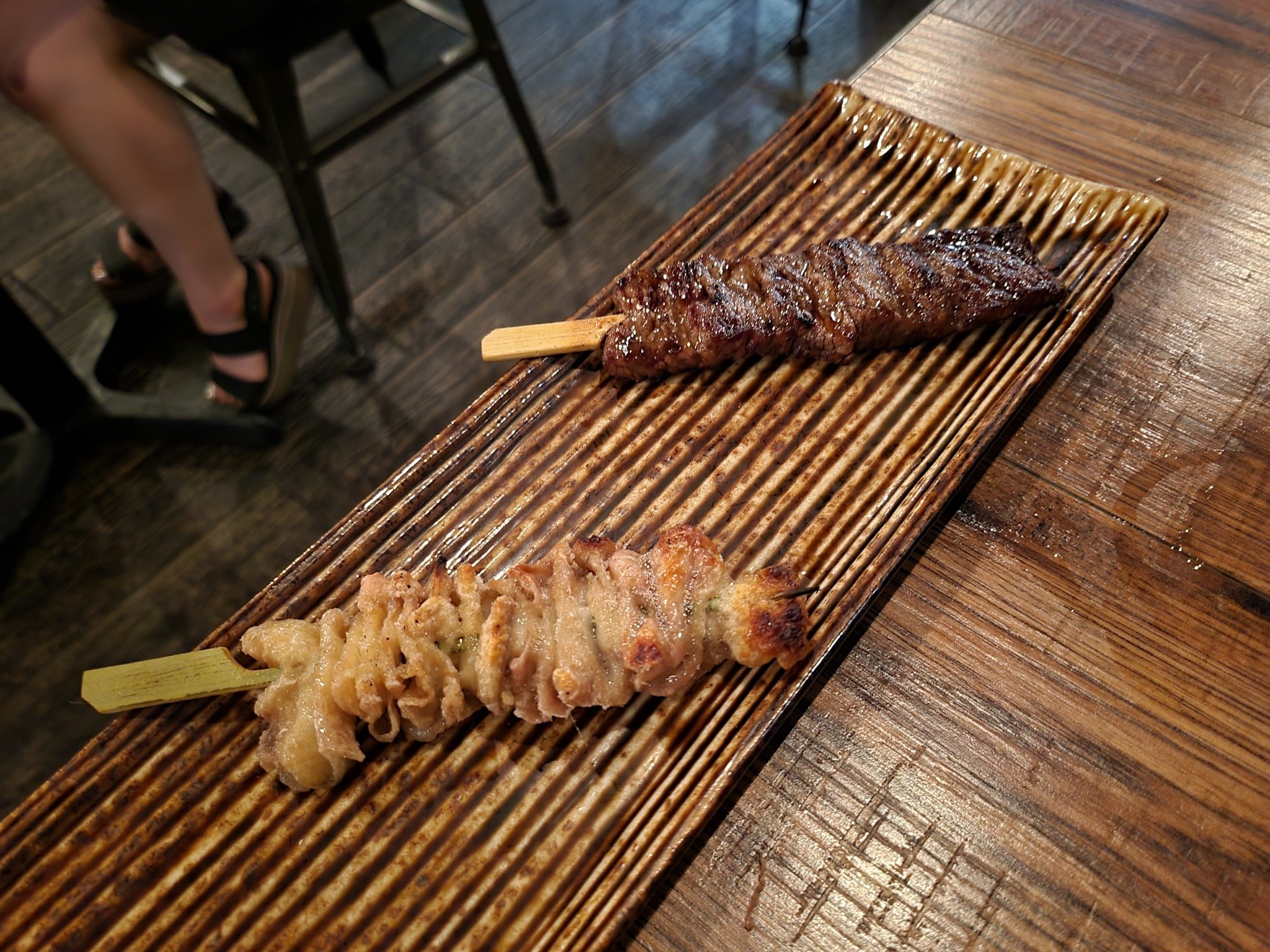


Taking pictures of your kids or pets can be challenging with some phone cameras — especially in low light — but I found the Fold 3 had no trouble keeping up with my son in any lighting condition. Multi-frame capture helps this significantly, and more than once, I noticed the camera would swap out the preview with another frame taken at the same time — another sign that Samsung's software has improved significantly in all the right ways.
Samsung has long sat among the very best when it comes to video recording, and that absolutely holds true with the Fold 3. Video quality itself is stellar — although if you were hoping for 8K resolution recording, you'll probably be disappointed — and I even found that zoom quality beyond 3x is better than what you'll get when taking photos. You'll also find that audio zooming is here and as good as ever, helping to block out background noise and focus on the subject you're zooming in on.
Like the rest of the software experience, everything on the video front is smooth and responsive. Adjusting the zoom levels through all three cameras is supremely smooth; it never resulted in a quick pop like I've seen on several other phones with multiple cameras. This is likely aided by the telephoto camera being only 2x, which isn't a huge focal adjustment from the main camera.
Galaxy Z Fold 3: Competition

One of the biggest draws of owning a Galaxy Z Fold 3 is that there aren't any phones quite like it. Samsung's other 2021 foldable, the Galaxy Z Flip 3, offers a very different form factor that's quite a bit smaller. It lacks S Pen support, a serious upside to the Fold 3. It also doesn't have a telephoto lens on its rear camera, though that doesn't make a notable difference given that the Z Fold 3 only sports a 2x lens. It's still the most similar device to the Z Fold 3 simply because it's got all of Samsung's software and foldable hardware expertise — and it costs $800 less.
If you're more interested in having the best cameras from any Samsung device, you could still save a few hundred bucks and pick up a Galaxy S22 Ultra instead. The S22 Ultra has the same S Pen support as the Z Fold 3 — including a smaller built-in S Pen for convenience — and offers the best camera experience Samsung has ever made. In fact, if you want the best overall camera, the Galaxy S22 Ultra is your ticket.
Suffice it to say, choosing just about any other phone on the market is going to feel like a setback in at least a few ways when compared to the Z Fold 3. You'll either sacrifice the uniquely amazing folding hardware and huge screen if you pick another phone, or you'll need to give up S Pen and water resistance if you pick up a second-hand Z Fold 2. It's a hard call to choose any other real alternative.
Galaxy Z Fold 3: Should you buy it?
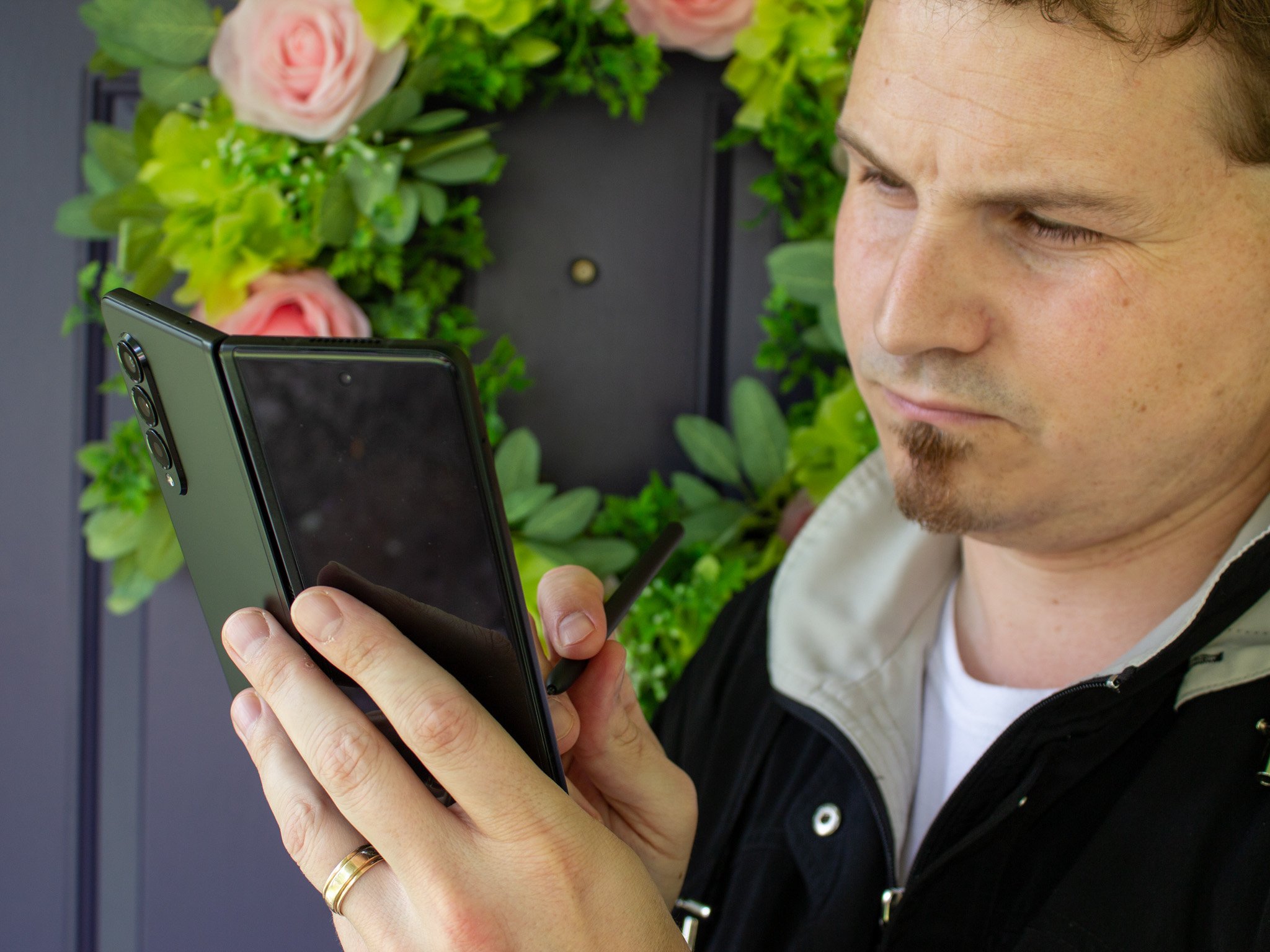
You should buy this if ...
You want the best foldable phone ever made
Samsung upgraded just about every one of the Z Fold 2's shortcomings on the Z Fold 3. Water resistance and a significantly better screen protector will help everyone, and a lower price makes it easier than ever for regular folks to afford one.
You love the Galaxy Note series
There's no Galaxy Note phone in 2021, but I don't much care after using the Z Fold 3. This is the Galaxy Note form factor I've been waiting for since the debut of the original Note, and it feels like the perfect digital notebook in every way.
You're a real multitasker
Two distinct screen sizes make every task easier, and the ability to split the big screen three ways (plus floating apps) makes it hard to discount how efficient multitasking is on this phone. Couple that with new multitasking features that make it more effortless than ever, plus a dedicated taskbar like a desktop OS has, and you'll get a more complete picture of what Samsung is going for here.
You should not buy this if ...
You want the very best cameras
The Galaxy Z Fold 3's cameras aren't bad by any means, but they're not the very best cameras you can get in most areas. Samsung's Galaxy S22 series outshines it in every way, and the Google Pixel 6 Pro outclasses the Fold 3's cameras entirely. Both of those phones are also a lot less money.
You don't like big phones
If you were hoping that a foldable form factor would significantly shrink the Z Fold 3, think again. While the narrow width of a closed Fold 3 certainly makes the phone reasonably pocketable, the huge 7.4-inch screen inside can realistically only be used with two hands. Even closed, it's the thickness of more than two phones stacked on top of each other.
You need epic battery life
Despite the large nature of the Fold 3, Samsung didn't pack in a huge battery. It's not likely you'll struggle to get through an entire day on one charge, but you'll certainly come close on the regular. You won't find lightning-fast charging speeds on this phone either — though 25W wired is decent — meaning top-ups will take more than just a few minutes.
The Galaxy Z Fold 3 is a power user's paradise in every way. Just about every usability option you could ever think of can be found on this phone, including several multitasking features that make it easy to use for everything you'd ever want. It's just a shame that Samsung didn't upgrade the cameras to better compete with the Galaxy S21 because, outside of that and the price, the phone doesn't have too many major shortcomings.
It's clear Samsung's goal was to make a more mainstream-friendly product that will begin to set the stage for Folds to come. Water-resistance is likely the single most important feature they could have added to ensure that everyday life doesn't ruin the Fold 3, and seemingly small hardware improvements like the new PET screen protector make a huge difference in everyday usage of the phone. It's a solid improvement that makes it more realistic for more people to own a Fold, and in that respect, Samsung achieved its goal for 2021.
The Galaxy Z Fold 3 is the first mainstream-ready Fold in many ways. While the price is still quite high, great offers from Samsung and the carriers make the phone easier than ever to get. Great software, a unique experience, S Pen capability, and reliable cameras all mean you'll continue to be happy long after buying the phone, too.
Samsung Galaxy Z Fold 3: 8 months later review
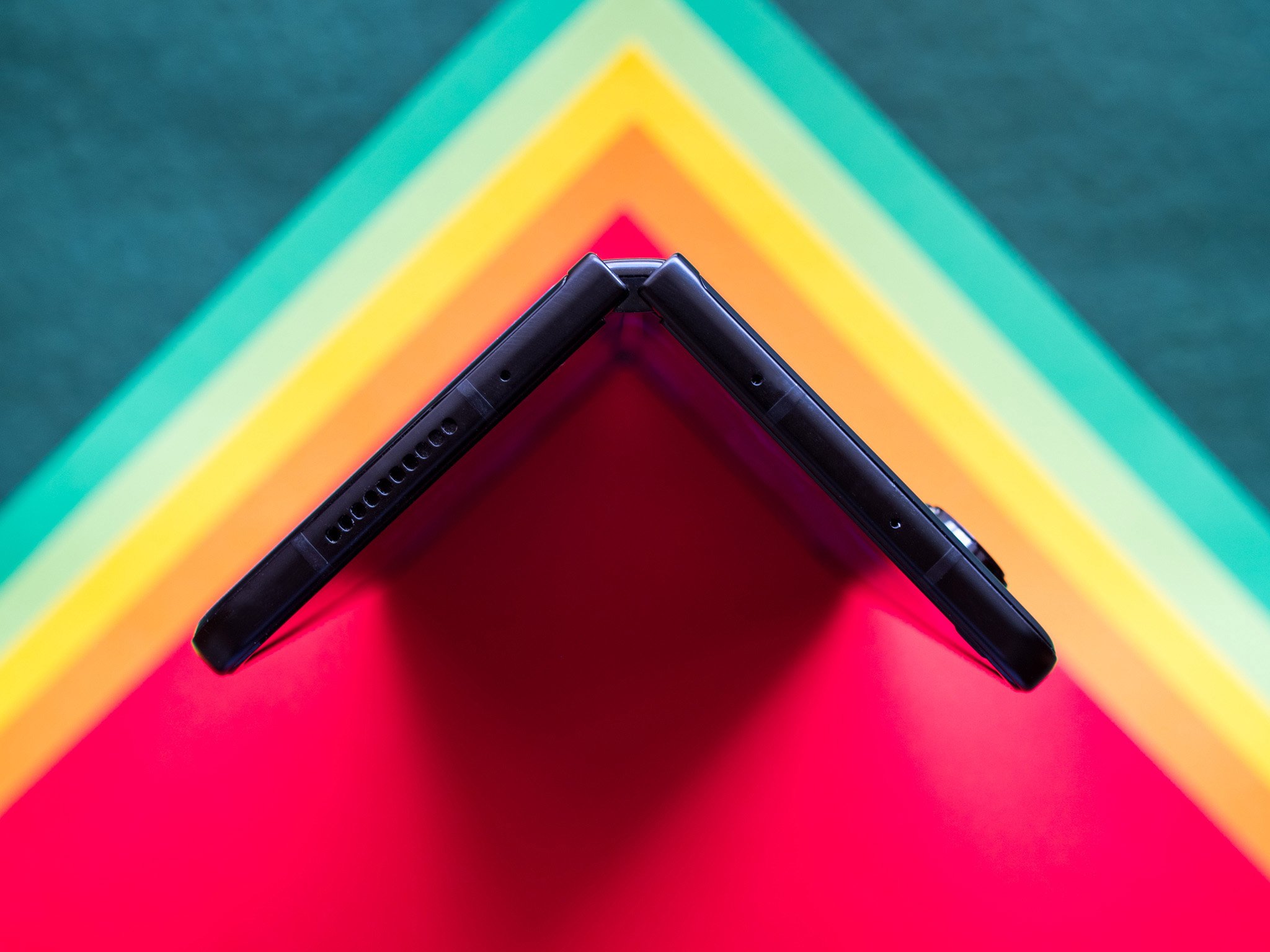
Over the past few months, I’ve found myself regularly oscillating between the Galaxy Z Fold 3 and the Pixel 6 Pro. While the Pixel 6 Pro’s cameras made me switch the moment the phone debuted, something keeps bringing me back to the Galaxy Z Fold 3. Namely, while the Pixel 6 Pro might offer me a better camera experience, Samsung’s lovable foldable is just so good for, well, everything else.
Let’s start first by addressing the elephant in the room: durability. Doubtless, many customers have been wary of buying one of Samsung’s foldables over concerns of screens magically cracking on their own or the concern that extra moving parts might result in greater fragility when dropped. Neither of these things has happened and, from what I can tell, aren’t even a concern in the eyes of most who own the phone.
The Fold 3 has survived drop tests better than most phones on that market, and while there have been reports of screens cracking here and there, this isn’t a widespread issue like we saw with the original Fold.
Similarly, only the outside screen protector on my Fold 3 has any real signs of wear and tear at all. Meanwhile, the larger inner screen looks as perfect as the day I started using it. Yes, that even includes the small scratches I accidentally made with the S Pen back in September, which have self-healed and disappeared completely.
I’ve also found that the Galaxy Z Fold 3 is, bar none, the best gaming phone I’ve ever used. Being able to dock it in any of the Nintendo Switch-like controllers available on the market — my personal favorite being the GameSir X-2 — makes playing games on the go an unbelievably enjoyable experience. Aside from the generally excellent performance of the phone, I’ve found that the almost 4:3 aspect ratio of the inner screen is something I didn’t realize I had missed from the olden days of gaming.
Even newer games like Fortnite benefit from this aspect ratio, which seems like it provides a grander view of the character’s surroundings while playing. There has been more than one time where I moved from a wider phone display back to this one and almost felt like I was “cheating” because of the display size and shape. Its advantage is not to be understated.
But beyond my love for the hardware itself is the software experience, which Samsung has continually improved since its launch. We’re now on One UI 4.1, which is built atop Android 12. In addition to the usual collection of feature additions that come with any major OS update, the Fold 3 is now more colorful and customizable than ever before. Samsung adopted Google’s Material You app style guidelines, which automatically themes any app that supports the new color-changing features of Android 12.
I’d say the biggest disappointment on the software side is the lack of meaningful updates for the actual folding portion of the experience. The odd app instability that we saw at launch has been solved, and the experience generally errs on the side of perfect, but there hasn’t been some big “oh my gosh” moment in any of the major software updates.
Mainly, I’d like to see better handling of tablet apps when using the big screen. Right now, if you open an app on the small screen and then fold open the big display, you normally just get a blown-up version of the same app. Some apps will properly reload themselves and present a tablet version — browsers like Microsoft Edge and Google Chrome are notable apps that do this — but so many apps either don’t bother or don’t have good tablet app interfaces.
Google aimed to change some of this with Android 12L — which Samsung helped build — but there’s still a ways to go before this feels as natural as I hope it one day will. Still, even with some ever-so-slight jank that occurs from having two very different size and shape screens, the Z Fold 3 experience remains unparalleled in every single way.
Review Changelog
This article was originally published in August 2021. It was updated in November 2021 with the following changes:
- Added mention of One UI 4 and Android 12L to the software section.
We updated it again in March 2022 with the following changes:
- Updated pricing section.
- Updated software version in specs.
- Updated usage info of screen protector durability in display section.
- Updated software section to talk about One UI 4's release.
- Added gaming performance to the software section.
- Replaced S21 Ultra with S22 Ultra in the comparison section.
- Added side navigation bar.
The April 2022 update included:
- Addition of the 8 months later review.

